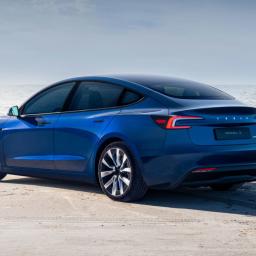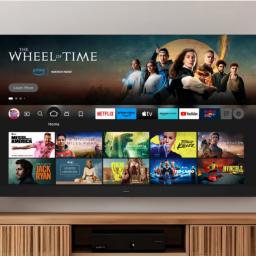 |
by Steve Dent on (#6HR46)
Urtopia has tried to separate its e-bike's from the pack with copious use of technology and this year the company has outdone itself. It just showed off its flagship Fusion model for the first time in full at CES 2024 (after teasing it earlier this year) and it's fully integrated with none other than ChatGPT, the buzzy AI assistant. The Fusion follows the company's previous tech-infused Chord and original Urtopia models.Urtopia calls the Fusion "the world's first dual battery, dual motor ebike by design visionary Hartmut Esslinger," a very specific claim. It's built with carbon fiber to reduce weight and uses a Shimano CUES derailleur on the regular model and Enviolo stepless shifter on the premium CVT version. The dual 540Wh battery allows for 120km of range (75 miles), but the 360Wh battery extender brings that up to 200km (124 miles) - enough to traverse Paris from north to south about 20 times.UrtopiaIt can hit up to 25 km/h thanks to the 95Nm mid-drive motor and has 100mm of travel with the air suspension fork. All that, combined with the relatively light weight (23 kg) wide tires and stable frame, make it suitable for off-road, trails and city riding.That could be any e-bike, but the Fusion's headline feature is the tech. It's connected by 4G and uses GPS tracking to keep you informed of the bike's location even if stolen. It also comes with a movement alarm, fingerprint unlock, route tracking, navigation without a cellphone and Bluetooth music via a built-in speaker - all as with past models.What's new is what the company calls "Jarvis" technology enabled by a smart ring (the company didn't say which one) to power the bike on, play music or activate the other tech feature, ChatGPT. You can also converse directly with ChatGPT through the built-in speaker. You may reasonably ask what ChatGPT is doing on an e-bike - the answer is that it can help you "explore new routes, get real-time information, and even engage in entertaining conversations," according to Urtopia.We're not sure how useful a chat assistant is when dodging traffic at 25 km/h, but it might at least keep you company on a lonely trail. It's also a pretty solid marketing gimmick that the company is using to separate itself from the many, many other e-bikes on the market. Buyers will have to be pretty well heeled, though, as the Fusion will cost 3,999 (around $4,375) and the Fusion CVT will run a hefty 4,999 ($5,467). There's no word yet on when it'll go on sale or if it will come to the US.We're reporting live from CES 2024 in Las Vegas from January 6-12. Keep up with all the latest news from the show here.This article originally appeared on Engadget at https://www.engadget.com/urtopias-fusion-e-bike-has-fully-integrated-chatgpt-144429572.html?src=rss
|
 Engadget is a web magazine with obsessive daily coverage of everything new in gadgets and consumer electronics
Engadget is a web magazine with obsessive daily coverage of everything new in gadgets and consumer electronics
| Link | https://www.engadget.com/ |
| Feed | https://www.engadget.com/rss.xml |
| Copyright | copyright Yahoo 2025 |
| Updated | 2025-12-20 11:17 |
 |
by Mariella Moon on (#6HR47)
Valve has introduced new rules to abide by that will allow the company to add more games with AI content to its Steam gaming platform. To start with, it's updating its content survey form for developers so that they can give the company a description of how they use artificial intelligence in their games. If they used AI tools to generate art, code, sound or any other kind of content for their title, developers must ensure that they do not include anything illegal or anything that infringes on someone else's copyright. Valve says it will evaluate each game and check if the developer has submitted truthful information.For live-generated AI content, developers have to tell the company what kind of guardrails they've put up to prevent their games from creating anything considered illegal. And since Valve will not be able to review all content games create in real time, it's launching a new system on Steam that will allow players to easily send in a report. If a player sees anything they believe should've been caught by appropriate guardrails, they can use Steam's new in-game overlay to notify the company.Valve said it will also be transparent with gamers when it comes with what kind of AI content a developer's title has by including their disclosure on their Steam store page. The company explained that the new rules are a result of it improving its "understanding of the landscape and risks" in the AI space. Last year, Valve admitted that it was still "working through" how to account for AI content in its review process after developers complained that the company was rejecting their submissions. It needed "some time to learn about the fast-moving and legally murky space of AI technology," Valve clarified in its new post. The company said it still can't release games with live-generated adult sexual content right now, but that it will revisit its rules as it learns more about the technology and as the legal issues surrounding it evolves.This article originally appeared on Engadget at https://www.engadget.com/valves-new-guidelines-will-allow-for-more-ai-content-in-games-134515623.html?src=rss
|
 |
by Billy Steele on (#6HR48)
Sennheiser announced two very different sets of wireless earbuds at CES 2024 here in Las Vegas, extending its Momentum line with a fourth-generation flagship model and a high-tech sport version. The company's premium earbuds have offered excellent sound quality for a while now, consistently earning the best overall audio in our best wireless earbuds list. We paid Sennheiser a quick visit to see how the two new sets stack up.There's no need to mince words here: The audio performance on the Momentum True Wireless 4 is outstanding. I only listened to them for a few minutes, but I had a hard time walking away. The jazz demo tracks the company selected played to the earbuds' strengths with excellent clarity and pleasant, inviting tuning. Active Noise Cancellation (ANC) also seems to be improved as I was able to silence a noisy hotel suite at the press of a button. Transparency mode is also better and more natural sounding, but you still don't get as much of your voice beamed back through the earbuds as you do on the AirPods Pro.Sennheiser clarified during my demo that its stated battery life on the Momentum True Wireless 4 of seven and a half hours is with ANC off. However, it explained that it has narrowed the gap in regards to noise cancellation impacting battery life as enabling it only reduces play time by 30 minutes.Sennheiser Momentum SportPhoto by Billy Steele/EngadgetI'm also happy to report there's no discernible drop off in audio quality with the Momentum Sport. There's still crisp, clear sound that's evenly tuned despite the company's goal of "impressive bass" for workouts. There's ample low-end tone here, but it didn't seem to be cranked any higher than the Momentum True Wireless 4. The size of the Sport model makes them very comfortable to wear and the ANC seemed to do a solid job blocking the roar of CES surrounding us.The Momentum True Wireless 4 goes on sale March 1 and the Momentum Sport will be available April 9. I'll be putting both sets of earbuds through their paces closer to their respective launch dates.We're reporting live from CES 2024 in Las Vegas from January 6-12. Keep up with all the latest news from the show here.This article originally appeared on Engadget at https://www.engadget.com/sennheiser-momentum-4-and-momentum-sport-hands-on-excellent-sound-in-two-very-different-earbuds-133029171.html?src=rss
|
 |
by Sam Rutherford on (#6HR49)
The original iPhone convinced me (and many others) that typing on touchscreens was the future. So the last thing I expected to test out during CES 2024 here in Las Vegas was a mobile accessory that's trying to bring back the physical keyboard. And, while I wanted to dismiss Clicks as a thing for people who can't let go of yesteryear, what I found was a gadget that's solving some modern problems by taking cues from the past.Clicks' design couldn't be simpler. It's a silicone case (Clicks' website actually says it's Liquid Silicon, but I think that's a typo) with a physical keyboard bolted on the bottom. There's a small vegan leather accent on the back, little bumps to accommodate buttons and switches, and a passthrough connector at the bottom (either Lightning or USB-C depending on your device). At launch, Clicks will be available for three devices starting at $139: the iPhone 14 Pro, the iPhone 15 Pro and the iPhone 15 Pro Max.Photo by Sam Rutherford/EngadgetThe first problem that Clicks tries to address is giving you back your screen space, because when you don't need to display a virtual keyboard at the bottom all the time, suddenly things feel a lot roomier. And Clicks accomplishes this with flying colors. But personally, with the increasing size of phones (especially new-fangled foldables), this has never really been an issue for me. But that doesn't mean this isn't a problem for others so it's nice to see Clicks providing people with alternatives to typing on glass.Another big goal for Clicks is optimizing your device by providing tons of shortcuts, which to me is much more appealing. It almost gives your phone the type of speed and productivity you enjoy on a laptop. You can press CMD+H to go home, tap the Spacebar to scroll in Safari, hit CMD+Space to open up Spotlight search and so much more. Some commands even work in third-party apps like Instagram, which is just really handy. And after seeing Apple add a single Action key on the iPhone 15 Pro, my head is already swimming with the possibilities of having 30+ customizable shortcuts.Finally, there's the simple joy of having physical keys to wail away on. While you don't get mechanical switches like on a desktop keyboard (Clicks features rubber domes), the tiny nickel-plated keycaps feel solid and offer a nice tactile bump with each press. You also get some handy backlighting so you don't have to suffer in dark rooms. The one issue is that after years of typing on screens, I'm not entirely sure I want to go back. And that probably goes double for anyone who prefers swipe-based entry methods.After years of typing on glass, just banging out a short text using Clicks felt lethargic. And even with their circular design which leaves ample space in between the keys, I found myself fumbling. But then old habits started coming back and I can easily see how those yearning for their old Blackberrys, Sidekicks, or Motorola Envys might be enchanted.Now that I've used it, I can't deny that there's something endearing about Clicks. But when it comes to getting more use out of a device, I lean more towards foldable phones or simply bigger screens. Plus, there are a few other minor issues, like iPhones not being able to handle charging and data over USB-C at the same time, which could be an issue for anyone who relies on wired CarPlay while using Clicks. Also by tacking a keyboard onto the bottom of an iPhone, which already have extra long 19.5:9 aspect ratios, you may feel like you're lugging around a stack of rulers. And if you have an Android handset, you're just plain out of luck (at least for now). But there's no doubt that Clicks is a charming device, especially those flashy yellow and blue/pink models.Clicks will be available starting on February 1 for the iPhone 14 Pro with the other models following sometime later this spring.We're reporting live from CES 2024 in Las Vegas from January 6-12. Keep up with all the latest news from the show here.This article originally appeared on Engadget at https://www.engadget.com/clicks-hands-on-a-charming-keyboard-for-2024-thats-relying-on-more-than-just-nostalgia-131537619.html?src=rss
|
 |
by Will Shanklin on (#6HR4A)
The US Department of Labor (DOL) published a final rule to the Federal Register on Wednesday that would increase the difficulty of classifying workers as independent contractors. If the rule survives court challenges unscathed, it will replace a business-friendly Trump-era regulation that did the opposite. It's scheduled to go into effect on March 11.The new rule, first proposed in 2022, could have profound implications for companies like Uber and DoorDash that rely heavily on gig workers. It would mandate that workers who are economically dependent" on a company be considered employees.The rule restores a pre-Trump precedent of using six factors to determine workers' classification. These include their opportunity for profit or loss, the financial stake and nature of resources the worker has invested in the work, the work relationship's permanence, the employer's degree of control over the person's work, how essential the person's work is to the employer's business and the worker's skill and initiative.In its decision to publish the new guidance, the DOL cites a longstanding precedent" in the courts predating the Trump administration's hard right turn. A century of labor protections for working people is premised on the employer-employee relationship," Acting Labor Secretary Julie Su said in a press call with Bloomberg.Misclassifying employees as independent contractors is a serious issue that deprives workers of basic rights and protections," Su wrote in the announcement post. This rule will help protect workers, especially those facing the greatest risk of exploitation, by making sure they are classified properly and that they receive the wages they've earned."Mike Kemp via Getty ImagesIf the rule takes effect, it's expected to increase employer costs. The US Chamber of Commerce, a non-government lobby for business interests, unsurprisingly opposes it. It is likely to threaten the flexibility of individuals to work when and how they want and could have significant negative impacts on our economy," Marc Freedman, VP of the US Chamber of Commerce, said in a statement to Reuters.DoorDash sounds optimistic that the rule wouldn't apply to its workforce. We are confident that Dashers are properly classified as independent contractors under the FLSA, and we do not anticipate this rule causing changes to our business," the company wrote in a statement. We will continue to engage with the Department of Labor, Congress, and other stakeholders to find solutions that ensure Dashers maintain their flexibility while gaining access to new benefits and protections."Groups with similar views are expected to mount legal challenges to the rule before it goes into effect. A previous attempt by the Biden Administration to void the Trump-era rules met such a fate when a federal judge blocked the DOL's reversal.Although the most prominent theoretical applications of the rule would be with gig economy apps like DoorDash, Lyft and Uber, it could stretch to sectors including healthcare, trucking and construction. The department is seeing misclassifications in places it hasn't seen it before," Wage and Hour Division Administrator Jessica Looma said to Bloomberg on Monday. Health care, construction, janitorial, and even restaurant workers who are often living paycheck to paycheck are some of the most vulnerable workers."This article originally appeared on Engadget at https://www.engadget.com/new-department-of-labor-rule-could-reclassify-countless-gig-workers-as-employees-130836919.html?src=rss
|
 |
by Billy Steele on (#6HR1F)
My experience with smoking meat has been entirely outdoors, using a mix of grills that burn charcoal, wood or pellets. Not everyone has the space for one of those setups, but thanks to GE Appliances' latest device, you can bring the barbecue indoors. Plus, you don't even have to been there while it's cooking. At the company's CES 2024 booth in Las Vegas, I finally got a taste of that the GE Profile Smart Indoor Smoker is capable of cooking.Lousiville-based chef and Food Network Chopped champion Dallas McGarity is with GE Appliances at CES this week. He explained that he's been using the Smart Indoor Smoker in his restaurant for infusing flavor in everything from spices to cheese and deviled eggs. Of course, when most people think of smoking foods, they think of meat. McGarity prepared a one-bite sampler to showcase the type of flavor we can expect from the device: beef tenderloin with a sweet and spicy rub, roasted garlic barbecue sauce, Southwest breadcrumbs and scallions. An elevated taster, for sure, but not too far from something you might prepare at home.After just a couple of hours in the Smart Indoor Smoker, the beef had noticeable flavor from the wood pellets. McGarity was also preparing a pork butt, but it still had several hours to go before it would be ready. Given my experience with outdoor smokers, even just one bite gave me a sense of what the GE Profile model was capable of. My main concern was the amount of smoke flavor it would impart, and it was great to see that the device managed infuse an ample amount in a limited time period. That bodes well for an 8- to12-hour low-and-slow smoke session.One other aspect of the Smart Indoor Smoker that I was able to see in action was the Clear Smoke function. Or, I should say, I got to see what happens when you don't use it. McGarity was keeping the beef bites warm in the device and, rather than make me wait 10 minutes for the cooking chamber to clear of smoke, he opened the unit and smoke wafted up in the air. Ideally, you wouldn't want to do this in your kitchen, but he worked fast and the cloud was minimal. Even still, the Smart Indoor Smoker recovered quickly, getting back to its target temperature with visible smoke returning in seconds.The cooker costs $1,000 and, unlike many other gadgets launched at CES, is already available at some retailers.Photo by Billy Steele/EngadgetWe're reporting live from CES 2024 in Las Vegas from January 6-12. Keep up with all the latest news from the show here.This article originally appeared on Engadget at https://www.engadget.com/we-tried-meat-from-the-ge-profile-smart-indoor-smoker-and-it-was-delicious-130029336.html?src=rss
|
 |
by Sarah Fielding on (#6HR1G)
Taylor Swift is not giving out free Le Creuset products in social media advertisements - though deepfakes of her voice would like you to believe otherwise. A series of posts have recently surfaced on TikTok and in Meta's Ad Library claiming to show Swift offering free Le Creuset cookware sets, the New York Times reports. The ads featured clips where Swift was near Le Creuset products and used a synthetic version of her voice. The scammers used AI to have the cloned voice address her fans, "Swifties," and produce other little remarks.These posts led interested parties to fake versions of sites like The Food Network with made-up articles and testimonials about Le Creuset. Shoppers were then asked just to provide the $9.96 for shipping to get their free products. Unsurprisingly, no Dutch ovens arrived, and customers had additional monthly charges added to their cards. Le Creuset confirmed no such giveaway was occurring.Swift is hardly the only celebrity who has recently found their voice co-opted using AI. She's not even the only one used in the scam, with interior designer Joanna Gaines mimicked in ads from verified accounts or ones labeled as sponsored posts. In April 2023, the Better Business Bureau warned consumers about the high quality of ads featuring AI-manufactured versions of celebrities. Since then, scammers have used deepfakes to convince consumers that Luke Combs was selling weight loss gummies, Tom Hanks was promoting dental plans and Gayle King was selling other weight loss products, to name a few examples.Little regulation exists for monitoring deepfakes or punishing the people who create them. A lot of the responsibility currently falls on the platforms, with YouTube, for example, laying out new steps for reporting deepfakes. At the same time, its working with select musicians to loan their voices out and create greater interest in AI-generated versions of real people.Last year, two bills were introduced in Congress to address deepfakes: The No Fakes Act and the Deepfakes Accountability Act. However, the fate of both pieces of legislation is uncertain. At the moment, only select states, such as California and Florida, have any AI regulation.This article originally appeared on Engadget at https://www.engadget.com/taylor-swift-deepfake-used-for-le-creuset-giveaway-scam-123231417.html?src=rss
|
 |
by Mariella Moon on (#6HR1H)
Hyundai has debuted its new air taxi concept, the S-A2, at CES 2024 in Las Vegas. The electric vertical takeoff and landing (eVTOL) vehicle is a follow-up to the S-A1 model it introduced at the same event back in 2020. Hyundai still envisions the S-A2 as an every day transportation solution for urban areas, one that could get passengers from point A to point B a lot more quickly than if they'd traveled by car or bus and had to contend with traffic.The S-A2 has a cruising speed of 120mph upon reaching an altitude of 1,500 feet and was designed to fly short trips between 25 to 40 miles. It has eight rotors and an electric propulsion architecture that the company says can operate "as quietly as a dishwasher" unlike loud traditional helicopters. Inside, the vehicle has seats for a pilot and four passengers, and it has lighting that provides visual cues, such as where to enter and exit. For safety purposes, it has a lot of redundant components, such as its powertrain and flight controls, which can take over if the main ones malfunction.Hyundai's air mobility company Supernal is hoping to achieve commercial aviation safety levels and to enter the market with an eVTOL vehicle by 2028. We might see future versions of the concept in the next CES events before that year - or after, if the company has to adjust its timeline. If and when Supernal does make it to market, it intends to use Hyundai's mass production capabilities to manufacture its eVTOLs and make sure its business is cost-effective.HyundaiWe're reporting live from CES 2024 in Las Vegas from January 6-12. Keep up with all the latest news from the show here.This article originally appeared on Engadget at https://www.engadget.com/hyundai-shows-off-its-updated-s-a2-air-taxi-at-ces-2024-115516581.html?src=rss
|
 |
by Sarah Fielding on (#6HR1J)
It's been about three months since we first saw Tesla sell an upgraded version of the Model 3 in Europe, China and the Middle East. Now, Tesla's 2024 Model 3 is available to purchase in the United States, Canada and Mexico. The sedan is a refreshed version with some clear changes between the models.Inside the Tesla 2024 Model 3 is a new eight-inch rear display that controls things like infotainment and climate. The front display remains the same size at 15 inches but is brighter and has a thinner bezel. The updated car also offers ventilated front seats, "softer, more sophisticated materials," and an audio system with up to 17 speakers. The entire 2024 Model 3 is outfitted with acoustic glass for a quieter drive and has customizable ambient lighting.The car's exterior also has some upgrades, with Tesla integrating the fog lights and indicators into the main headlights. The 2024 Model 3 also foregoes the front bump with "styling optimized for maximum aerodynamics." At the rear, the lights fully connect versus two separate pieces. Plus, there are two new color options: Ultra Red and Stealth Grey.The Model 3 is available in two types. The new Real Wheel Model 3's range remains at 272 miles. Notably, its alternative, the 2024 Long Range Model 3, has a slightly increased EPA estimated range of 341 miles versus its predecessor's 333 miles. This boost - albeit minor - comes at a time when Tesla is lowering many of its listed driving ranges in response to a new US government regulation testing vehicles to ensure they're providing accurate estimates. Tesla has previously manipulated the number displayed in cars to appear higher and even set up a secret team in 2022 tasked with suppressing range complaints and canceling service appointments about range limits.Tesla's 2024 Model 3 is now available to order with an estimated delivery of January or February. The Real Wheel Mode starts at $38,990, with the option to lease for $329 monthly. The Long Range Dual Motor All-Wheel Drive Model 3 is available for $45,990 or $439 per month if leasing.This article originally appeared on Engadget at https://www.engadget.com/teslas-refreshed-2024-model-3-is-now-on-sale-in-the-us-111533256.html?src=rss
|
 |
by Cherlynn Low on (#6HQZ2)
The first truly busy day of CES 2024 has come and gone and it feels like we've been run over by a giant metaphorical eighteen-wheeler full of press conferences. From home robots to electric vehicles to AI, laptops and processors, there was news from pretty much all areas of tech. There were pleasant surprises like Samsung's cute new Ballie robot ball and Sony's spatial content creation headset, and intriguing concepts like Razer's vibrating cushion for gamers. We also got exactly what we expected in the form of new processors from the likes of AMD, Intel and NVIDIA, as well as the subsequent flood of laptops carrying the just-announced chips for 2024.And for everyone else, this CES also saw the launch of things like headphones, electric vehicles, gaming handhelds, grills, gaming phones, e-ink tablets, strange hybrid devices, noise-suppressing masks, standing desks and more. It's a free for all and we're nowhere near done. Here's just a small selection of the biggest news out of CES 2024's press day, right before the show officially opens.Samsung and Sony's press conferences had some of the best surprises this year. Samsung showed us a new version of its Ballie robot, which is cute as heck. It's basically a yellow bowling ball with a projector built in and can send you text messages and video clips of what's at home while you're out. You can ask it to close your curtains, turn on your lights or stream your favorite yoga video to your ceiling while you lie on your back for a meditative session. Samsung told The Washington Post that Ballie will be available for sale some time this year, but did not say how much it would cost. I guess that's another surprise we can look forward to in the coming months.Then there's Sony, which brought us a few unexpected demos, starting by driving its Afeela concept electric car onstage using a PlayStation controller. Then, it showed off its mixed reality headset for spatial content creation," which sounds somewhat similar to Apple's Vision Pro and Microsoft's HoloLens. Sony's does appear to target content creators, though, and looks like a pared down PSVR2 headset. It'll be powered by a Snapdragon XR2+ Gen 2 chipset, sport dual 4K OLED microdisplays and have user and space tracking. The new Sony headset still has no name, no price, but itwill be available later this year.Also dominating our news feeds on Day 1 was the barrage of chip news coming from Intel, AMD and NVIDIA. AMD, for example, launched a new Radeon RX 7600 XT GPU, which is a slight upgrade from last year's entry-level model. The company also brought processors with neural processing units for AI acceleration to its desktop offerings by announcing the Ryzen 8000G series.Meanwhile, NVIDIA unveiled the RTX 4080 Super, RTX 4070 Ti Super and RTX 4070 Super, which will cost $999, $799 and $599 respectively. It also announced updates for its GeForce Now cloud gaming service, adding G-Sync support and day passes for streaming. Intel kept things fairly tame and tidy, simply giving us its complete 14th-generation CPU family, including HX-series chips like a 24-core i9 model. It also launched the Core U Processor Series 1, which is designed to balance performance and power efficiency in thin and light laptops.Speaking of laptops, most PC makers followed up the chip news flood by announcing all their new models containing the latest silicon. We saw notebooks from Alienware, Lenovo, MSI, Acer, Asus, and Razer, among others. MSI also had a new gaming handheld to show us, which is the first of its category to use Intel's just-announced Core Ultra chip.Asus also put that chip in a non-laptop product, debuting a new homegrown NUC. Meanwhile, Lenovo continued to challenge our notions of what a laptop with its ThinkBook Plus Gen 5, which is a weird gadget mermaid of sorts. Its top half is a 14-inch Android tablet, while its bottom half is a Windows keyboard and all of it is just funky.Speaking of odd Android tablets, TCL was here with a new version of its NXTPAPER e-ink-ish tablet. This year's model can switch between a matte e-paper-like display and a full-color LCD at the push of a button. The company also showed off a miniLED TV, which, at 115-inches large, is the biggest MiniLED TV with Quantom Dot technology to date.We also got to check out Razer's Project Esther, which is a proof of concept vibrating cushion showcasing the company's new Sensa HD haptics platform for more immersive gaming experiences. That might be one of my favorite demos so far because... well... It vibrates. It's a vibrating cushion for most office or gaming chairs.There was plenty of car and transportation news, too, like Kia's new fleet of modular vans and Volkswagen adding ChatGPT powers to its in-car voice assistant. The CES 2024 showfloor was also littered with piles of headphones, earbuds (and earwax) thanks to announcements from JBL, Sennheiser and less-known names like Mojawa, which put an AI-powered running coach in its bone-conducting headphones.At the Pepcom showcase, we also saw some intriguing and fun products, like the Skyted Silent Mask that lets you talk in private in public, as well as the LifeSpan standing desk bike that lets you cycle really hard to generate enough power to charge your phone.Intrigued? Check out our articles and videos with more details on everything I've mentioned and more. Or if you prefer, we'll be back tomorrow to recap all the biggest news again to make your life easier. We've got plenty of press conferences coming up, and the show floor has officially opened, which means there's still lots of stuff to check out in the days to come.We're reporting live from CES 2024 in Las Vegas from January 6-12. Keep up with all the latest news from the show here.This article originally appeared on Engadget at https://www.engadget.com/ces-2024-day-1-recap-samsung-and-sony-dominated-as-did-chips-and-laptops-140024127.html?src=rss
|
 |
by Steve Dent on (#6HQZ3)
Wearable startup Humane AI laid off four percent of its employees before it has started shipping its Ai Pin, The Verge has reported. Leadership reportedly told employees that budgets would be lowered in 2024, according to sources familiar with the matter. The cuts were implemented earlier this week and affect around 10 people.On LinkedIn, CEO and co-founder Bethany Bongiorno called the cuts "part of a wider refresh of our organizational structure as our company evolves with purpose for this next phase of growth." She added that CTO Patrick Gates will be transitioning to an advisor role, and that Humane AI had promoted new heads of hardware, software and others as part of a reorganization. Bongiorno told The Verge that the cuts were "not communicated as a layoff," though sources told that outlet that they were, both verbally and in writing.Humane was founded by ex-Apple executives Bongiorno and her husband Imran Chaudhri. It's primary product is the "Ai Pin" that acts as a sort of wearable AI assistant. The company first unveiled the device at a Paris fashion show and announced last month that it would start shipping in March for $699.HumaneThe pin takes voice commands from the user and beams relevant information onto the user's hand via a built-in projector. It can also perform AI-powered optical recognition via a camera. It's powered by a quad-core Snapdragon processor with a dedicated Qualcomm AI Engine using Cosmos OS software. The founders have said that it "quickly understands what you need, connecting you to the right AI experience or service instantly."The Ai Pin has yet to be thoroughly reviewed (other than a few short tests), but the company demonstrated how it works in a video released last month. The founders showed how you can give it specific commands like "play music written by Prince, but not performed by Prince." The device can then display the information on your hand via the projector and control music playback and more by tilting or closing your hand.It can also answer questions by searching the web and send messages with modifiers like "add more excitement." You can use it to monitor your health and nutrition, and Humane provides a central hub for images, etc., along with accessories like clips, battery cases and more. How well it performs its AI tasks in the real world, though, remains to be seen.This article originally appeared on Engadget at https://www.engadget.com/humane-lays-off-staff-before-its-ai-pin-begins-shipping-103548514.html?src=rss
|
 |
by Steve Dent on (#6HQXB)
Amazon-owned Twitch is preparing to lay off 35 percent of its employees or around 500 people, Bloomberg has reported, citing "people familiar with the matter." The move follows a headcount reduction of around 400 people in 2023 and Twitch's decision to cease operations in Korea. The cuts could be announced Wednesday, but no other details were provided, including who may be affected.The move was reportedly made amid concerns over losses at Twitch, which has failed to become profitable nine years after Amazon acquired it for nearly $1 billion. The costs of running the site are huge, given that it supports around 1.8 billion hours of live video content a month. A similar issue forced Twitch to leave South Korea, though CEO Dan Clancy said costs there are "ten times more expensive" than other countries.Near the end of last year, several key executives departed the company, including its chief product officer, chief customer officer, chief revenue officer and chief content officer. Clancy himself has been CEO less than a year, as he replaced co-founder and CEO Emmett Shear in March of 2023.In attempts to boost profitability, Twitch has reworked the way it does advertising and pays streamers in recent years. The site had over 50,000 partner creators back in 2022 and many have reportedly praised Clancy for using a more hands-on approach and listening to their concerns.Parent Amazon has been on a cost-cutting mission, having laid off 27,000 employees over the last two years, including 9,000 in 2023. That's part of a downturn across tech companies, with large-scale layoffs last year at Google, Meta, Spotify, Epic Games, Unity and others.This article originally appeared on Engadget at https://www.engadget.com/twitch-is-reportedly-laying-off-35-percent-of-its-workforce-085946333.html?src=rss
|
 |
by Mariella Moon on (#6HQVX)
ASUS has introduced quite a lengthy list of products at CES 2024 in Las Vegas, including a high-tech eyewear called the AirVision M1. It's not really a competitor to the upcoming Apple Vision Pro and the mixed reality headgears other companies debuted at the event, though. The AirVision M1 is a wearable display with the ability to generate multiple virtual screens, supposedly so that users can juggle several tasks at once. It's equipped with an FHD (1,920 x 1,080) Micro OLED display that has a 57-degree vertical perspective field of view.The device's system has three degrees of freedom, and users can pin several screens where they want in the aspect ratio they prefer, whether it's 16:9, 21:9 or 32:9. They can do so through the glasses' intuitive touchpad located on the left temple, where they can also adjust brightness and activate 3D mode. The device also comes with built-in noise-canceling microphones and speakers.While it may sound like the AirVision M1 could be a good companion for people who need to bring their work with them when they travel, it's not a standalone wearable: It has to be connected to a PC or a phone via USB-C to work. ASUS has yet to reveal how much it costs and when it'll be available, but its specs and capabilities indicate that it'll cost a fraction of Apple's Vision Pro.We're reporting live from CES 2024 in Las Vegas from January 6-12. Keep up with all the latest news from the show here.This article originally appeared on Engadget at https://www.engadget.com/the-asus-airvision-m1-is-a-wearable-display-for-multi-taskers-060237509.html?src=rss
|
 |
by Karissa Bell on (#6HQQW)
TikTok recently pulled a tool that allowed researchers and others to study the popularity of hashtags on its app. The change, first reported by The New York Times, came shortly after researchers published a report using data from the tool that criticized the company.As The New York Times points out, the tool was one of the few publicly-accessible methods of tracking details about the popularity of specific hashtags. TikTok, like other social media companies, has made it difficult for outsiders to track how content spreads in its app.The tool in question is a feature called Creative Center, which provides data about the popularity of hashtags to would-be advertisers and others. Researchers at Rutgers' Network Contagion Institute had used Creative Center's search function to track hashtags deemed sensitive" to Chinese government interests. The researchers compared the prevalence of the hashtags between TikTok and Instagram and concluded that many "sensitive" topics were "dramatically underrepresented on TikTok" compared with Instagram.Soon after the report was published, the researchers said the search feature in Creative Center disappeared without an explanation. Search capacity for Hashtags has itself now been removed from the user interface entirely, which NCRI discovered to have occurred on Christmas day, days after this report's initial release," they wrote in an addendum to the report. They added that TikTok had also disabled direct access to a number of sensitive" topics they had previously tracked, including hashtags related to US politics and other geopolitical issues.In a statement to The New York Times, TikTok confirmed the change. Unfortunately, some individuals and organizations have misused the Center's search function to draw inaccurate conclusions, so we are changing some of the features to ensure it is used for its intended purpose," a company spokesperson said.The dust-up is the latest example of mounting tensions between social media companies and researchers trying to study thorny topics like misinformation. Meta has also found itself at odds with researchers, and reportedly plans to deprecate CrowdTangle, a tool widely used by researchers and journalists to study how content spreads on Facebook. X has also greatly restricted researchers' access to data since Elon Musk took control of the company, making its once open APIs prohibitively expensive to most groups.In TikTok's case, the company may be particularly sensitive to what it considers improper use of its tools. The company has for years denied that it aligns its content policies with the interests of the Chinese government as numerous government officials have called for the app to be banned. More recently, the company faced increased scrutiny over its handling of content related to the Israel-Hamas war - criticism that was also fueled by what the company said was an inaccurate portrayal of hashtag data.That said, the company has made some concessions to researchers. TikTok began offering an official Research API to some academic institutions last year, and reportedly plans to make the tools available to some civil society groups that have questioned the company's content moderation practices.But for researchers, the move to abruptly cut off a tool will likely fuel more questions about just how willing the company is to work with them. This lack of transparency is of deep concern to researchers," the NCRI researchers wrote.This article originally appeared on Engadget at https://www.engadget.com/tiktok-pulled-a-hashtag-tracking-feature-researchers-used-to-study-the-platform-015454077.html?src=rss
|
 |
by Daniel Cooper on (#6HQNY)
If there's a problem with the world of ambient computing we're all expected to live in, it's that you can't really be discreet. Most commands to your voice assistant of choice have to be spoken at a volume slightly higher than you would speak to another person. That's the societal ill VTouch, a South Korean company, has chosen to tackle with its WHSP Ring. It's a ring with a proximity sensor and microphone that activates when you raise it to your mouth. So when you want to talk to your assistant, you can simply mutter toward your knuckle and have it understand you. I saw a brief demo on the first day of CES 2024 here in Las Vegas.The idea is that you'll utilize VTouch's own app, which will offer a number of AI assistants to aid you. This includes, in the example shown to me, an AI Art Curator or even a digital Psychiatrist, all of which can be accessed from your phone. You can also interact with your smart home, setting all of the usual parameters from the comfort of your hushed tones. It'll last for around a day and a half on a single charge, while the charging case you can take around with it will extend the life by up to nine days. Any responses will, of course, be pumped through your headphones, enabling you to chat" to your assistant. There's even a button that, if tapped five times at once, will trigger a system to alert your contacts of an emergency and record ambient sound.Touch is planning to launch WHSP Ring as a Kickstarter in the near future, but there's no word yet on how much you could expect this thing to cost or when you can get your hands on one.We're reporting live from CES 2024 in Las Vegas from January 6-12. Keep up with all the latest news from the show here.This article originally appeared on Engadget at https://www.engadget.com/this-ring-lets-you-whisper-to-your-phone-because-sometimes-we-need-to-use-our-inside-voices-002529204.html?src=rss
|
 |
by Terrence O'Brien on (#6HQNZ)
Yes, you probably already have a virtual assistant in your pocket on your phone. Heck, if you're reading Engadget, I'm willing to bet you've got at least one smart speaker floating around your home as well that you can ask to complete basic tasks. But a new startup called Rabbit seems to think these are less than ideal implementations of AI (if you can really call Siri and Alexa that). The company, which is exhibiting at CES 2024 in Las Vegas this week, envisions a world where you trade apps for conversation and, rather than a distracting device shoving icons in your face, you interact with what amounts to a walkie-talkie for an AI.The R1 is the first device to be launched by Rabbit and it's an objectively adorable little square in an endearingly bright shade of orange. Even if you're not sold on the necessity of a dedicated gadget for a virtual assistant, it's hard to deny the aesthetic appeal, which comes courtesy of the design gurus at Teenage Engineering. It features a small 2.88-inch touchscreen, an analog scroll wheel, two mics, a speaker and a "360 degree rotational eye," which is just a fancy name for a camera you can spin to face toward you or through the back of the handset.The primary way you interact with the R1, though, is by pressing and holding the "Push-to-Talk" button. This tells Rabbit OS to start listening. A heavily stylized and disembodied rabbit head bobs slowly as you ask your question or give it a task, and then it quickly gets to work. Want to book an Uber? Need a recipe to use up the leftovers in your fridge? Wondering who sampled The Isley Brothers "That Lady"? (The answer is Beastie Boys, Basement Jaxx and Kendrick Lamar, FTR.) The R1 seems pretty capable of handling those tasks, at least in the controlled video demo.Rabbit OS is able to tackle those tasks using what it calls the Large Action Model (LAM). This is what founder and CEO Jesse Lyu pitches as the company's major innovation. It's designed to take actions on interfaces rather than through APIs or apps. In short, it can be trained to carry out almost any task that can be accomplished through a user interface. It's sort of like a fancy version of a macro.As a way of demonstrating its capabilities, Lyu teaches the R1 how to generate an image using Midjourney via Discord. Once Lyu walks and performs the process, with Rabbit OS recording his actions, it can repeat the task when asked.The rotating camera faces up into the body by default, acting as a sort of privacy shutter. Only turning its sensor towards its target when summoned. It can do the usual tricks like identify people or thing in the real world (within reason, at least). But the way it interacts with the AI is sure to pique people's interest. In the demo Lyu points the R1 at a full refrigerator and asks it to suggest a recipe that's "low in calories" based on its contents.RabbitOf course, there are still a lot of unanswered questions about the R1. How is the battery life? The company claims it's "all day," but what does that really mean? And will the average user be able to train it easily. At least we know a few things, though. We know it costs $199 and is available for preorder now, with an expected ship date sometime in March or April.We're reporting live from CES 2024 in Las Vegas from January 6-12. Keep up with all the latest news from the show here.This article originally appeared on Engadget at https://www.engadget.com/rabbit-r1-is-an-adorable-ai-powered-assistant-co-designed-by-teenage-engineering-001051537.html?src=rss
|
 |
by Daniel Cooper on (#6HQP0)
EVs, like me after the holidays, have a tendency to bloat at the slightest provocation, which is why I can't fit into those size 34 jeans. The big issue for electric cars is heavy batteries force cars to grow in size to accommodate them. Of course, the heavier the load, the more power is needed to keep going, forcing you into a vicious cycle. Even a small city car like the original Smart has, in its latest electric version, grown into a grotesque parody of its predecessor. Which is why there's a lot of hope riding on truly small EVs, like Squad Mobility's solar-powered car that's designed not to grow too big to fit inside a city.The company was founded by Chris Klok and Robert Hoevers, who met while working on the Lightyear solar car. Klok was chief vehicle engineer of that project, while Hoevers was previously involved with NIO's Formula E team. But they left Lightyear to help develop a small, solar-powered car that would offer affordable and clean mobility for dense cities. And while it's just got a few prototypes to show off, like the one here at CES 2024 in Las Vegas, it's expecting to begin production in 2025. Even better, many of its existing pre-order customers are based in the US, given the need for a car like this in those communities that exclusively rely on golf carts to get around.The Solar City car has a 250Wp panel in its roof, which is designed to generate enough power for a few short trips each day. The company says that, in Las Vegas, you could expect to travel for around 13 miles purely from the energy collected from the panel. (You can plug it in to an outlet if you really need to.) With a kerb weight of 794 pounds, it's light and efficient enough to get you around short distances without much stress. Of course, the speed is limited - and you'll only get around 25mph out of the 4kW motor, but if you live in a big city and just need to get to work, or pick up some groceries, that's probably all you need.You might expect the car to be poky, but the high roofline and low floor means it's surprisingly comfortable. The prototype here has some quirks - like acceleration and brake pedals that are a bit too close to the seat - which will be eliminated in the production version. There's even a rear load space big enough for a suitcase or a couple of decently-sized bags, and the prominent tires mean you could even tackle rough terrain in short doses. The fact it measures just 6.6 feet long means you can park it sideways and it'll take up the same amount of room as most cars, too.We're still a year out from seeing the production model of this car, but there are plenty of reasons to be hopeful. The company expects the retail price to be $6,250 excluding sales tax, making it ideal as a city runaround or second (or third) car. That said, the figure does exclude the cost of the doors which, like AC, count as an optional extra.We're reporting live from CES 2024 in Las Vegas from January 6-12. Keep up with all the latest news from the show here.This article originally appeared on Engadget at https://www.engadget.com/squad-mobilitys-tiny-solar-powered-ev-is-a-dream-for-crowded-cities-235540577.html?src=rss
|
 |
by Sam Rutherford on (#6HQP1)
Right now there are a bunch of companies trying to figure out new and better ways to work on the go. Lenovo made a laptop with two displays and a detachable keyboard to help give owners additional screen space without too much added bulk. And there are headsets from Meta, Apple and others that offer a way to create a completely virtual workspace without the need for a tethered PC. But with the Spacetop, startup Sightful has come up with an in-between solution that uses the bottom of a laptop, but instead of a traditional display, it's attached to a pair of AR glasses.In theory, the glasses provide a 100-inch virtual display that can hold more windows than you could ever fit on a traditional laptop screen. And with the Spacetop being powered by Android, you get a familiar working environment too. Instead of controllers or hand gestures, there's a typical keyboard and touchpad for writing, browsing the web or anything else you might need to do. But after trying one out at CES 2024 in Las Vegas, while I like the idea, I'm not so sure about Sightful's execution.The system is powered by a Qualcomm Snapdragon XR2 chip (the same processor Meta used in the Quest 2 from 2020), just 8GB of RAM and 256GB of storage. It feels smooth, though I wouldn't necessarily call it fast. I didn't notice much lag when dragging windows around or typing, but I didn't get to see how it handles a ton of open apps or anything more demanding than a web browser. Sightful has also come up with some simple shortcuts for doing things like re-centering the screen (just press the left and right Shift keys at the same time).The issue I ran into is that, while Sightful developed the base of the laptop itself and put its logo on the side of the glasses, the bundled AR eyewear attached to the PC is actually off-the-shelf specs from Xreal (in this case the Xreal Lights). So while Xreal glasses are somewhat sharp, their narrow field of view (especially vertically) and somewhat small sweet spot left a lot to be desired when it came to actually using that 100-inch virtual display.Photo by Sam Rutherford/EngadgetAdditionally, the Spacetop's keys felt spongy and its touchpad was lackluster too. It's a far cry from the more precise haptic surfaces you'd get on a premium Mac or Windows PC. And when you combine all this with a starting price of $2,000, I just don't see the appeal. For people who already have a laptop, I'd argue you'd be much better off getting a Meta Quest 3, which costs $500, sports a much newer chip and can sync with your laptop to create its own version of a virtual desktop. Plus, then you'd have a headset that's way better at playing games, watching movies and more.Photo by Sam Rutherford/EngadgetThere's a reason why Meta, Apple and others have sunk billions of dollars into making headsets and glasses with finely tuned optics. And I'm sure someday (maybe even sometime in the next few years), off-the-shelf AR glasses will make some pretty big advancements. But between its high price, dated specs and a big but not great-looking virtual display powered by two-year old AR glasses, the Spacetop doesn't quite deliver on the promise of revolutionizing the common laptop.We're reporting live from CES 2024 in Las Vegas from January 6-12. Keep up with all the latest news from the show here.This article originally appeared on Engadget at https://www.engadget.com/the-spacetop-is-a-laptop-that-really-wants-to-swap-your-screen-for-ar-glasses-ces-2024-233638523.html?src=rss
|
 |
by Cherlynn Low on (#6HQP2)
Imagine being at a crowded convention or noisy bar and trying to have a conversation with someone across from you. It's tough enough for people with hearing to focus on what the person is saying, not to mention those with hearing loss. Assistive technology company OrCam has rolled into CES 2024 with a host of new products including a set of devices and an iPhone app designed to help those with hearing loss deal with auditory overload. The platform is called OrCam Hear and after a quick hands-on at the show in Las Vegas, I'm pleasantly surprised.OrCam Hear consists of a pair of earbuds and a dongle that plugs into any phone, and you'll use the app to control who you want to listen to. The system listens to voices for a few seconds (via the dongle) and uses AI to create speaker profiles for each person that then allows you to "selectively isolate specific voices even in noisy environments." This targets the issue sometimes known as the "cocktail party problem" that's a challenge for hearing aids.During a demo, my editor Terrence O'Brien and I spoke to two people whose voice profiles were already set up in the app. We stood around a table with Terrence on my right and the two company spokespeople across us about five feet away. I put the earbuds in (after they were sanitized), and the noise around me immediately sounded a little less loud and a lot more muffled.Photo by Terrence O'Brien / EngadgetI looked at everyone around me and though I could see their lips moving, I couldn't hear anyone speaking. After OrCam's reps used the app to drag a floating circle into the ring surrounding me, I started to hear the person diagonally across me talk. And though the executive next to him was also moving his mouth, I could still only hear the voice of the person selected. Only after we moved the other speaker's icon into the ring did I start to hear them.What impressed me more, though, was how the system handled relatively new participants like Terrence. He didn't have a profile set up in the app, and I initially couldn't hear him at all. A few seconds into the demo, though, a new circle appeared with a gray icon indicating a new "Anonymous" person had been recognized. When we dragged that into the ring, I was suddenly able to hear Terrence. This was all the more impressive because Terrence was wearing a fairly thick mask, which would have made him hard to understand any way. Yet, I was able to clearly make out what he was saying.The OrCam Hear isn't perfect, of course. I was still able to hear the speakers as they talked, and the audio playing through the earbuds was slightly delayed, so there was a small echo. But people who have hearing loss, whom this product is designed for, aren't likely to experience that. There was also some audio distortion when the selected speakers were talking, but not so much that it impeded my comprehension.OrCam said that the Hear platform is "currently in a technology preview phase and is expected to be shipped later in the year." Hopefully, that gives the company time to iron out quirks and make the app available on both iOS and Android, so that the assistive tech can be truly inclusive and accessible to more people.We're reporting live from CES 2024 in Las Vegas from January 6-12. Keep up with all the latest news from the show here.This article originally appeared on Engadget at https://www.engadget.com/orcam-hear-hands-on-a-surprisingly-effective-voice-isolation-platform-for-those-with-hearing-loss-230243953.html?src=rss
|
 |
by Karissa Bell on (#6HQP3)
The official X account belonging to the Securities and Exchange Commission was briefly compromised," the regulator said, after an apparently rogue post on X temporarily juiced bitcoin prices.On Tuesday, the SEC's official X account tweeted that bitcoin ETFs had been approved for listing on all registered national securities exchanges." The tweet included an official-looking graphic featuring a quote from SEC Chair Gary Gensler. However, Gensler himself quickly clarified from his X account that the post from @SECGov was the result of a "compromised" account.The @SECGov twitter account was compromised, and an unauthorized tweet was posted," Gensler wrote. The SEC has not approved the listing and trading of spot bitcoin exchange-traded products."Screenshot via XThe confusion comes as the SEC is, in fact, considering whether to approve spot bitcoin ETFs, investment funds that hold the cryptocurrency. The regulator is expected to make a decision Wednesday in a process that has been closely watched by crypto investors.Naturally, the now-deleted tweet from the SEC's official (and gray check-verified) account on X prompted a momentary surge in bitcoin prices, followed by a steep decline. The post and subsequent clarification from Gensler wiped out over $50 million of leveraged derivatives trading positions within an hour," according to and analysis from CoinDesk.It was initially unclear exactly how the SEC's X account was compromised." In a statement, an SEC spokesperson told Engadget that it was investigating the matter. "The SEC has determined that there was unauthorized access to and activity on the @SECGov x.com account by an unknown party for a brief period of time shortly after 4 pm ET," the spokesperson said. "That unauthorized access has been terminated. The SEC will work with law enforcement and our partners across government to investigate the matter and determine appropriate next steps relating to both the unauthorized access and any related misconduct."X didn't immediately respond to a request for comment, but the company shared the results of its "preliminary investigation" Tuesday evening."We can confirm that the account @SECGov was compromised and we have completed a preliminary investigation," X write in a post from its safety account. "Based on our investigation, the compromise was not due to any breach of X's systems, but rather due to an unidentified individual obtaining control over a phone number associated with the @SECGov account through a third party. We can also confirm that the account did not have two-factor authentication enabled at the time the account was compromised."
|
 |
by Malak Saleh on (#6HQJY)
Today, at CES 2024 in Las Vegas, Honda revealed two concept EVs - a sedan dubbed the Saloon and the minivan-esque Space-Hub. Honda said it will develop a model based on the Saloon concept car for North American markets in 2026, before it eventually reaches other buyers in Asia, Europe, the Middle East, South America and Africa. Additionally, the carmaker debuted a redesigned 'H' logo that will be exclusive to its EV lineup.The Saloon, which is its flagship concept EV, has an aerodynamic design and rides low to the ground. While the Space-Hub is quite a bit boxier and renders show it with seating that has passengers facing each other. Besides touting a spacious cabin, Honda did not share much about when or if it plans to actually manufacture a car inspired by the Space-Hub concept.The first entries in Honda's 0 Series lineup will feature advanced driver-assistive systems that pair with the carmaker's Sensing Elite software. In the latter part of the decade, Honda expects the 0 Series to gain automated driving features through the integration of AI.Around the same time the company expects to implement dramatic improvements to its battery technology, like fast charging from 15 to 80 percent in around 15 minutes and reducing battery degradation to less than 10 percent over 10 years. Those are bold goals, especially for a company that is a little late to the EV space.HondaWe're reporting live from CES 2024 in Las Vegas from January 6-12. Keep up with all the latest news from the show here.This article originally appeared on Engadget at https://www.engadget.com/honda-debuts-two-futuristic-0-series-ev-concept-models-at-ces-2024-225422387.html?src=rss
|
 |
by Nathan Ingraham on (#6HQJZ)
Samsung's Ballie robot is one of the more delightful things we've heard about at CES 2024. The spherical robot was a surprise from Samsung yesterday, though the company first showed off a version of it back in 2020. Ballie's now a lot bigger, growing from a tennis ball to a bowling ball, and it has a built-in projector.Unfortunately, Samsung isn't letting us get any one-on-one time with Ballie here in Las Vegas, but the company did show off a demo at its booth. It was obviously tightly scripted and controlled, but at the very least it gave us an idea of how the company envisions Ballie being used. The actor asked Ballie to start a workout routine for him and it started projecting a workout video on the wall and started some tunes. Sure, you could just use your TV for that, but when one of the exercises called for laying down, Ballie shot the video to the ceiling so the actor could continue following along.In another example, Ballie was able to give a visual representation of the house's air quality, pulling data from a connected air purifier. In addition to showing some stats on the wall, Ballie noted that a filter needed to be changed. The idea here is to show that Ballie can talk to all your smart home devices and display info from them, even if they don't have a dedicated display.Naturally, Ballie can also display events on your calendar and place phone calls, and it can show video from things like the inside of your Samsung fridge or oven as well as when someone is at your doorbell. Basically, Ballie feels like a smart home hub on wheels that can also display stuff when you want it to.It's cute, and it was fun to see Ballie confidently rolling around the floor of the demo area, but I can't help but think that it's solving exactly zero real world problems either. We'll have to see how development progresses, but Samsung says it'll be on sale by the end of the year. I'm not fully convinced, as we've seen a lot of, but I am definitely rooting for the little robot.We're reporting live from CES 2024 in Las Vegas from January 6-12. Keep up with all the latest news from the show here.This article originally appeared on Engadget at https://www.engadget.com/samsungs-ballie-robot-didnt-do-much-at-ces-2024-but-it-sure-is-cute-221425179.html?src=rss
|
 |
by Malak Saleh on (#6HQK0)
Qualcomm is ringing in the new year at CES 2024 in Las Vegas with some updates in its chip lineup that power virtual and mixed-reality headsets. The keynote, which will detail more about what's new for its anticipated AI-powered chip, will happen on January 10 at 5pm ET. It can be streamed on Qualcomm's website or directly on the CES keynote page.What to expectThere might be some information divulged about Meta and Qualcomm's chip collaboration and how it could improve functionality on new gen VR headsets. Qualcomm has said that the technology has been engineered into a single chip architecture that allows it to support smaller and sleeker headsets.The AI-integrated chip technology will not only make it easier to track a headset user's hands, controllers and eyes during use, it will also deliver better display resolution per eye. The Snapdragon XR2+ Gen 2 chip will offer up to 4.3k by 4.3k resolution per eye, as well as upgraded raw image processing and full color display.Cristiano Amon, the CEO of Qualcomm is also going to focus on generative artificial intelligence and how Snapdragon platforms will integrate AI on devices from smartphones to PC gaming systems. Amon's keynote is in alignment with the company's overall move towards investing in AI hardware in its offerings, which we saw in its recently revealed mobile chipset for Android devices.We're reporting live from CES 2024 in Las Vegas from January 6-12. Keep up with all the latest news from the show here.This article originally appeared on Engadget at https://www.engadget.com/watch-qualcomms-ces-2024-keynote-on-its-highly-anticipated-ai-powered-chip-220039557.html?src=rss
|
 |
by Mat Smith on (#6HQK1)
This year, LG Display came to CES 2024 with something to prove. It had multiple sizes of transparent OLEDs (the show's theme appears to be transparent displays) and a gaming monitor capable of 480Hz refresh rates - double what we're used to seeing. Perhaps the most interesting things at its showroom were LG Display's most advanced OLED panels yet, featuring its META technology 2.0. While it sounds like promotional fluff (and there's some of that here), the company is trying to address arguably OLED's biggest weakness.While the company revealed its META technology last year, version 2.0 features advanced microlens arrays (now called MLA+). These are micrometer-sized lenses with a Dragonfly eye design that improves the viewing angle of OLED displays up to 160 degrees. These lenses (and there are 42.4 billion of them in LG Display's 83-inch 4K prototype), combined with new algorithms result in an OLED far more brighter than its predecessors - 42 percent brighter than conventional OLEDs, according to the company.META 2.0 could address one of the biggest criticisms of OLED compared to rival screens- whether Mini or MicroLED - that it can't get bright enough. LG Display says its META 2.0 OLEDs can hit 3,000 nits of brightness.Why would you want an even brighter OLED? Combining MLA+ with a new brightness-optimizing algorithm analyses scenes in even more detail, to enhance both peak and also color brightness. These next-gen OLED displays can reach color brightness of up to1,500 nits - 114% brighter than conventional OLEDs. A new detail-enhancing algorithm will also attempt to accurately render bright and darker images, where detail is sometimes lost. It's not just a matter of image quality either - the technology offers power savings too.LG Display's 83-inch 4K META 2.0 OLED demonstration display will apparently be joined by 55-, 65- and 77-inch options, as well as 8K OLEDs as big as 88 inches. These will reach consumer TVs, monitors, and the rest - just in time to go head-to-head with the latest, brightest MicroLED rivals.We're reporting live from CES 2024 in Las Vegas from January 6-12. Keep up with all the latest news from the show here.This article originally appeared on Engadget at https://www.engadget.com/lg-displays-next-gen-oled-panels-address-the-techs-biggest-weakness-001551026.html?src=rss
|
 |
by Lawrence Bonk on (#6HQGH)
Netflix's long-anticipated sci-fi series 3 Body Problem finally has a full trailer, following a short teaser released last year. This new trailer is over two minutes long and absolutely filled with exciting moments and tantalizing clues. Watch it below.The show's based on a hit book series by Chinese author Liu Cixin. The showrunners include David Benioff and D.B. Weiss, formerly of Game of Thrones. Yes, everyone hates them because of the ending of HBO's fantasy epic, but here's the thing. 3 Body Problem is the first novel in the finished Remembrance of Earth's Past series, and the earlier seasons of Game of Thrones, when working from pre-existing material, were absolutely iconic. So this could be very good, though it has suffered from delays.As for the plot, well it's complicated and hard to even discuss without getting into spoilers. The books are out there if you can't wait until the show's March 21 release date. As a clue, the clunky title actually refers to a common problem with both classical physics and quantum physics involving Newton's laws of motion and universal gravitation. In other words, it's hard sci-fi, but the books have plenty of action and mystery set-pieces, and the show looks to follow suit. Expect plenty of advanced technologies and otherworldly weirdness.3 Body Problem stars Benedict Wong, Eiza Gonzalez and several Game of Thrones alums including Jonathan Pryce and John Bradley. Besides Benioff and Weiss, screenwriter Alexander Woo is on-board as a co-showrunner. Woo's best known for his work on True Blood and The Terror, among other well-regarded series.This article originally appeared on Engadget at https://www.engadget.com/netflixs-sci-fi-adaptation-3-body-problem-finally-gets-a-full-sized-trailer-200027248.html?src=rss
|
 |
by Kris Holt on (#6HQGJ)
NASA is delaying its return to the Moon with the Artemis program. "To give Artemis teams more time to work through the challenges with first-time developments, operation and integration, we're gonna give more time on Artemis 2 and 3," NASA Administrator Bill Nelson told reporters on a call.As such, Artemis 2, which had been scheduled for a November 2024 launch, is now targeting September 2025. That four-person mission is set to fly around the Moon, in a similar fashion to the uncrewed Artemis 1. As for Artemis 3, which will take humans back to the lunar surface for the first time since 1972, that's now targeted for September 2026, marking a nine-month delay.Those are the only delays NASA has announced for now. Nelson said "Artemis 4 remains on track for September 2028." Along with a lunar landing, that mission will mark the delivery of a habitat module to the Lunar Gateway, a space station that's planned for lunar orbit.
|
 |
by Karissa Bell on (#6HQD9)
SAG-AFTRA, the union representing thousands of performers, has struck a deal with an AI voice acting platform aimed at making it easier for actors to license their voice for use in video games. Under the deal, which was announced during a press event at CES 2024 in Las Vegas, SAG-AFTRA members will be able to work with Replica Studios to license their voice to game studios.Duncan Crabtree-Ireland, the union's top negotiator, said that the agreement paves the way for professional voiceover artists to safely explore new employment opportunities for their digital voice replicas." The agreement comes as Hollywood is still grappling with the use of AI. Last year, SAG-AFTRA reached a deal with Hollywood studios that included AI protections following a months-long strike. As a result, studios are now required to pay actors (and obtain their consent) before using an AI-generated version of their likeness.SAG-AFTRA's latest agreement with Replica Studios seems to follow a similar framework. According to Crabtree, the agreements cover the creation of so-called digital voice replicas" and how they can be used by game studios and other companies. The deal has provisions for minimum rates, safe storage and transparency equirements, as well as limitations on the amount of time that a performance replica can be employed without further payment and consent."Notably, the agreement does not cover whether actors' replicas can be used to train large language models (LLMs), though Replica Studios CEO Shreyas Nivas said the company was interested in pursuing such an arrangement. We have been talking to so many of the large AAA studios about this use case," Nivas said. He added that LLMs are out-of-scope of this agreement" but they will hopefully [be] things that we will continue to work on and partner on."SAG-AFTRA's deal with Replica only covers a sliver of the game industry. Separately, the union is also negotiating with several of the major game studios after authorizing a strike last fall. I certainly hope that the video game companies will take this as an inspiration to help us move forward in that negotiation," Crabtree said.We're reporting live from CES 2024 in Las Vegas from January 6-12. Keep up with all the latest news from the show here.This article originally appeared on Engadget at https://www.engadget.com/sag-aftra-strikes-deal-for-ai-voice-acting-in-video-games-at-ces-2024-191533846.html?src=rss
|
 |
by Lawrence Bonk on (#6HQDA)
The modern classic mystery game Immortality is finally coming to PS5 on January 23 and it'll cost $20, which is in line with the price on other platforms. It already exists on PC, Xbox Series X/S, Android and iOS. The game was originally released back in 2022.For the uninitiated, Immortality is more of an interactive film trilogy than a video game, recalling full-motion titles from the 1990s. The surreal narrative tasks you with solving the disappearance of an actress named Marissa Marcel. You do this by scrubbing through video clips and gathering clues. Creator Sam Barlow has likened the gameplay to a mental Metroidvania", in that you return to previously-viewed clips once you have a new understanding of some aspect of the mystery.We loved the title upon release and it made our list of the best games of 2022. The script, penned by writers behind films like Wild at Heart and TV shows like Mr. Robot, is not just good for a video game, but engaging throughout. The atmosphere is moody and tense, recalling the cinematic stylings of Alfred Hitchcock and, especially, David Lynch. Immortality is geared more towards cinephiles than mainstream gamers, so don't expect a lot of action. The acting performances, however, are excellent.Sam Barlow made a similar game called Her Story, which was also well-received, and the less popular Telling Lies. He's been involved with several entries in the Silent Hill franchise, including Silent Hill: Origins and Silent Hill: Shattered.This article originally appeared on Engadget at https://www.engadget.com/cinematic-mystery-game-immortality-comes-to-ps5-on-january-23-191054771.html?src=rss
|
 |
by Daniel Cooper on (#6HQDB)
EcoFlow has arrived at CES 2024 in Las Vegas to show off its largest and most useful home battery backup solution, the Delta Pro Ultra. It's calling the hardware a smart hybrid whole house battery generator and backup" that will draw power from a wide variety of sources. You'll be able to charge it from either high or low-output solar panels, from the grid, or even juice it up from a gas powered generator. (But also, don't do that unless lives are on the line, please, the planet can't handle it.) The Delta Pro Ultra also vastly increases how much power you can keep on hand at any one time. The existing Delta Pro can scale - with additional batteries - up to 25kWh but, if your wallet is thick enough, you can equip the Ultra with 90kWh of batteries, which the company says should be enough to keep your home's essentials running for up to a month.In fact, the theme of this hardware is supersized capaciousness since every element of it has been built to service the most extravagant McMansions. For instance, the solar input can take up to 16.8kW of power at a time, letting you wire up to 42 400W panels at a time. Combined with the ability to draw extra power from the grid when energy costs are low and you should see the initial outlay paid back fairly quickly. And the company says output runs from 7.2kW - enough to run a Central Air unit - all the way through to 21.6kW with enough additional gear, which should be enough to power most key appliances in your home.On its own, the Ultra is plug-and-play, although if you want to take advantage of its higher outputs and deeper integration with the home, you'll have to buy its Smart Home Panel 2. That will of course require the services of a qualified contractor but, even so, the company says that installation is pretty clean and tidy. Not to mention that it's nice and quiet when outputting less than 2,000W to help avoid complaints from the neighbours.If you're looking to splash out on a new whole house battery backup system, the Delta Pro Ultra is available to order starting today. For the first month, the inverter and battery will set you back $4,999, while the Smart Home Panel 2 costs an extra $1,599 when bought separately. Not to mention you can snag both in a bundle for $6,399 until February 9, when prices for all three will leap up to their RRP of $5,799 (Ultra), $1,899 (Panel 2) and $7,499 (bundle).We're reporting live from CES 2024 in Las Vegas from January 6-12. Keep up with all the latest news from the show here.This article originally appeared on Engadget at https://www.engadget.com/the-ecoflow-delta-pro-ultra-is-a-home-battery-that-can-harvest-power-from-42-solar-panels-190032452.html?src=rss
|
 |
by Will Shanklin on (#6HQDC)
Palworld, often described as Pokemon with guns," finally has an Early Access release date. In addition to its violent battles, the game tackles labor exploitation themes with a sardonic sense of humor while adding (perhaps) just enough changes to evade Nintendo's lawyers. It launches in Early Access on Steam and Game Pass on January 19.At first glance, Palworld's trailers make the game look like a simple and charming 3D open-world riff on Pokemon. You'll see battles with strange monsters, vaguely resembling those in the creature collecting franchise, including players capturing them inside a sphere after a victory.PocketpairBut Palworld also takes things to darker places Nintendo would never dream of. For example, take this slice of developer Pocketpair's Steam FAQ about the game. In response to What kind of game is this?", it reads, Pals can be used to fight, or they can be made to work on farms or factories. You can even sell them or eat them!"A section of the FAQ on building reads, Want to build a pyramid? Put an army of Pals on the job. Don't worry; there are no labor laws for Pals." On factories and automation, it says, Letting Pals do the work is the key to automation. Build a factory, place a Pal in it, and they'll keep working as long as they're fed - until they're dead, that is." The game's trailers showcase piles of Pal corpses to prove the point.For yet another example of the game's dark undertones, take the video above, Using Pals Efficiently." To build a great base, catch a Pal and make it work," the voiceover says, repeating the last part twice for emphasis. Simultaneously, we see various Pokemon-like monsters sweating away constructing the player's headquarters.The narration continues: Creating a productive base like this," as we see a yard full of Pals swinging hammers, is the secret to living a comfortable life in Palworld." The player circles them, holding an assault rifle to ensure they're on task.Palworld will be available in Early Access on January 19 at 00:00 PST. You can catch them all - and put them to work -on Steam and Game Pass (Xbox Series X/S, Xbox One and Windows).This article originally appeared on Engadget at https://www.engadget.com/pokemon-with-guns-satire-palworld-launches-in-early-access-on-january-19-185152491.html?src=rss
|
 |
by Kris Holt on (#6HQDD)
The second season of HBO's adaptation of The Last of Us is about to go into production. That means we're starting to find out the actors who have been cast in key roles from the second game, including the most pivotal new character of them all, Abby. No spoilers here, but Kaitlyn Dever, the star of Booksmart and No One Will Save You, is taking on the challenging role. (Let's just say we hope she nukes all of her social media accounts.)Our casting process for season two has been identical to season one: we look for world-class actors who embody the souls of the characters in the source material," the show's co-creators Craig Mazin and Neil Druckmann told Variety. Nothing matters more than talent, and we're thrilled to have an acclaimed performer like Kaitlyn join Pedro [Pascal], Bella [Ramsay] and the rest of our family."
|
 |
by Mat Smith on (#6HQDE)
Sony's big press event at CES 2024 didn't reveal much for the first half, retreading the company's entertainment successes in TV, film and music. Then, out of the blue, it revealed an as-yet-unnamed mixed reality headset, with almost anime-looking controllers.SonyWhile there are some design similarities, this isn't a VR headset a la PSVR. This is for spatial content creation." The headset is powered by Qualcomm's Snapdragon XR2+ Gen 2, announced just as CES began. This means it's a self-contained device that doesn't require a computer. Sony CEO Kenichiro Yoshida said the 4K OLED microdisplays on the headset would offer a crisp viewing experience" and intuitive interaction for 3D design."The headset has a pair of controllers. One is described as a ring controller" for manipulating objects and the other as a pointing controller" for... pointing. Sony envisions creators being able to craft 3D models in real time with them.It all seems a more creative interpretation of Microsoft's HoloLens. We haven't yet seen the headset in person, though. Hopefully, we'll get more details from Sony's booth, here in Las Vegas.Oh, and the company drove its incoming Afeela EV on stage with a PlayStation controller. That's CES. For all the latest CES news, find all our stories right here.- Mat SmithThe biggest stories you might have missedThe MSI Claw is the first gaming handheld built on Intel's Core Ultra chipsWatch Sony's CES 2024 keynote in under 6 minutesLockly's Visage smart lock can unlock doors by scanning your faceFormlabs shows up at CES 2024 with more realistic 3D-printed teethYou can get these reports delivered daily direct to your inbox. Subscribe right here!Lots of refreshed laptops landed at CES 2024Intel's updated chips need to go somewhere.EngadgetYesterday, Intel revealed its entire 14th-generation CPU family, which includes powerful HX series chips, like the 24-core i9-14900HX, as well as new mainstream desktop CPUs. That means, of course, lots of new laptops. We've got impressions and reports on new ASUS, Alienware, Acer, Lenovo and Razer computers, but I'd point you toward the weirdest PC we saw so far: the Lenovo ThinkBook Plus Gen 5. As pictured here, the bottom is a Windows laptop deck, and the display is a 14-inch Android tablet. You can use the tablet as a standalone Android device, a wireless monitor for the laptop base or a Wacom-like drawing display.Continue reading.Samsung's Ballie robot ball showed up at CES 2024 with a built-in projectorAnd a yellow new look.SamsungSamsung showed off a robot named Ballie, which has a projector built in. Interestingly, though, according to a report from The Washington Post, Samsung said the robotic sphere will actually be available for sale within the year.We first saw an early iteration of Ballie in 2020, touted as a household assistant and potential fitness assistant, with such sophisticated skills as opening smart curtains and turning on the TV. But four years later, it's a little different. It's now bowling-ball-size" and has a spatial LiDAR sensor and a 1080p projector. The latter has two lenses and allows the robot to display movies, video calls and greetings" on its surrounding surfaces.Continue reading.
|
 |
by Sam Rutherford on (#6HQDF)
Between the Zenbook 17 Fold, Project Precog and previous Zenbook Duo machines, it feels like ASUS has been working towards building a true dual-screen laptop for ages. And now at CES 2024, that time has come with the arrival of the simply named Zenbook Duo.Similar to Lenovo's Yoga Book 9i, the Zenbook Duo features two separate screens and a detachable Bluetooth keyboard that can be stashed inside the system for traveling. The difference is that ASUS' OLED panels look even better, as they are slightly larger at 14 inches, while also offering a 3K resolution, 120Hz refresh rate and stylus support. Plus, with a starting price of $1,500, it costs $500 less than the Yoga Book and not that much more than your average high-end ultraportable.That alone would be enough to make it interesting, but what really elevates the Zenbook Duo is the polish ASUS has put into making it look and function just like a regular clamshell. Measuring just 0.78 inches thick and weighing 3.64 pounds (including its removable keyboard), it's only a touch larger and heavier than a typical 14-inch notebook. And it doesn't give up anything in terms of performance, with an Intel Core Ultra 9 185H CPU, up to 32GB of RAM and a 1TB SSD inside,. The same thing goes for connectivity, where you get two Thunderbolt 4 ports, a USB-A 3.2 slot, a 3.5mm audio jack and even a full-size HDMI 2.1 socket.Photo by Sam Rutherford/EngadgetBut the best thing about the Zenbook Duo is its fit and finish. Even though what I got to mess around with was a pre-production model, it felt incredibly sturdy. When packed up with its keyboard sandwiched between the two screens, there are no gaps or wasted space. And despite its super shallow dimensions, the detachable keyboard features full backlighting and more than enough travel to make sure your fingers don't get sore while typing.ASUS also added something I wish Lenovo had included on the Yoga Book 9i: a built-in kickstand. By mounting one on the bottom of the laptop, it sidesteps the need to have a separate folding cover, which streamlines the process every time you have to pack up and go. The small downside is that the orientation of the kickstand promotes a stacked setup with one display on top of the other. Though I'm not that bothered since that's my preference anyway. Technically, you can use the Zenbook Duo with vertical side-by-side mode, but because there's no way to adjust the kickstand in this position, it's not quite as flexible.Photo by Sam Rutherford/EngadgetAs you'd expect from a system like this, you can use it as a standard clamshell with the Zenbook Duo featuring hidden magnets that allow the keyboard to snap neatly in place. However, when you have more room to work with, you can place the keyboard in front of the system and instantly double your screen space. There's also a responsive virtual keyboard and touchpad you can use in a pinch along with handy widgets for the news, weather and monitoring system performance. And when you need to top up the removable keyboard's battery, there are some thoughtfully placed pogo pins that allow it to trickle charge while it's nestled inside the system.Surprisingly, when it comes to battery life, ASUS managed to fit a 75 Whr power pack in the Zenbook Duo which is slightly larger than what's available in the new Zephryus G14 (73 Whr), and that's a gaming machine with way fewer moving parts. And ASUS claims the Zenbook Duo adheres to MIL-STD 810H testing standards, so it should be pretty durable too.Photo by Sam Rutherford/EngadgetLast year, the Yoga Book 9i felt like a revelation; Lenovo combined all the right components needed to create an appealing dual-screen laptop. But ASUS has optimized that template even further by adding ports, moving to bigger and better screens, including a built-in kickstand and making it even more portable. And then there's that surprisingly affordable $1,500 starting price. I've been waiting for years to switch over to a dual-screen laptop, and the Zenbook Duo might actually convince me to finally make that jump.The ASUS Zenbook Duo is expected to go on sale sometime later in Q1 2024.We're reporting live from CES 2024 in Las Vegas from January 6-12. Keep up with all the latest news from the show here.This article originally appeared on Engadget at https://www.engadget.com/the-asus-zenbook-duo-is-a-stunning-dual-screen-laptop-with-seemingly-no-compromises-180017370.html?src=rss
|
 |
by Will Shanklin on (#6HQDG)
Google is expanding its smart home integration at CES 2024. The company said Tuesday that, in the future, LG TVs and some Google TV (and other Android TV) products will work as Google Home hubs. Considering Google's support for the Matter smart home standard, the move could make it easier for customers to set up and control their smart homes without buying a Nest device.In the future, LG TVs and select Google TV and other Android TV OS devices will act as hubs for Google Home," Google Android VP Sameer Samat wrote in today's announcement blog post. So if you have a Nest Hub, Nest Mini or compatible TV, it's easy to add Matter devices to your home network and locally control them with the Google Home app."The announcement closely aligns with a comment teased by Google's Eric Kay during LG's CES 2024 press conference. LG TVs will act as hubs for Google Home where you can easily set up and control any Matter device," Kay said. You'll be able to see, control, and manage both LG and Google Home devices right from the TV or the ThinQ app. These features will roll out later this year."The eventual move will give smart home customers more options to set up and control a Google Home setup -including for Matter devices. Currently, you need a Google Nest device to do that.We're reporting live from CES 2024 in Las Vegas from January 6-12. Keep up with all the latest news from the show here.This article originally appeared on Engadget at https://www.engadget.com/lg-tvs-will-soon-be-matter-compatible-google-home-hubs-180015856.html?src=rss
|
 |
by Amy Skorheim on (#6HQ9R)
A promotion at Sling TV is taking 50 percent off your first month of service. Sling divides its offerings in two: Sling Blue and Sling Orange, with different channels in each package. Those go usually for $40 per month separately or $55 monthly combined, but are now down to $20 and $27.50 after the discount. Unlike a cable subscription, you can cancel whenever you'd like with no penalty. Sling TV is one of the many ways to watch live TV channels, including sports and news stations, without having the commitment or higher price of cable. We named it a top pick in our live TV streaming guide.Sling TV is our recommendation for the most customizable live TV streaming service, letting you get just the channels you want without paying for too many you won't watch. Sling Orange includes six exclusive channels like the ESPN stations and the Disney Channel, while Sling Blue gives you 14 exclusive channels including FS1, MSNBC and Fox News. Both options come with 24 other channels such as CNN, BET and TNT. In addition to the two packages, you can choose from a number of add-on bundles that go for between $6 and $11 per month. Those include blocks of sports, kid-friendly fare, lifestyle channels and news packs. Premium extras include Starz, Showtime and Acorn which will add $2 to $10 to your monthly bill. In larger market areas (such as Los Angeles, Seattle, Dallas, NYC and Miami), Sling TV will also grant access to local NBC, ABC and Fox affiliate channels for no extra charge.We liked the way the menus were organized and found them easy to navigate. The service also does a good job of recommending stuff to watch based on your history. We had a little trouble with the service freezing occasionally and felt the 50 hours of DVR allowance could be more generous, but if you're looking for a cheaper alternative to cable and don't want to pay for channels you don't need, Sling is a good way to go.Follow @EngadgetDeals on Twitter and subscribe to the Engadget Deals newsletter for the latest tech deals and buying advice.This article originally appeared on Engadget at https://www.engadget.com/sling-tv-subscriptions-are-half-price-for-your-first-month-174537428.html?src=rss
|
 |
by Lawrence Bonk on (#6HQ9S)
Vehicle-based voice assistants are the next great frontier, incorporating artificial intelligence into the driving experience. At CES 2024, Amazon and BMW announced a partnership to significantly improve the pre-existing experience, marrying a large language model (LLM) with Alexa and the actual driver's manual. The end result? You can ask the Alexa-powered chatbot anything about your car and receive accurate real-time information. That's right. That thick and unwieldy manual can stay in the glovebox, for good.Amazon says this tool offers a more natural way of getting to know your new car." You can ask how various features work, like the parking assistance system, and get conversational answers. Both companies suggest that this voice technology will strip away complexity and minimize distractions in the car."It's not just an information delivery system. You can also ask the bot to take actions on your behalf, like entering a specific drive mode. Additionally, this will fully integrate with the infotainment system, so you'll be able to ask the assistant to turn on music, navigate to a destination, change the internal temperature and just about anything else.BMW has been using Amazon Alexa in its infotainment systems for years, but this is a significant step forward. The companies previously announced a partnership to build a custom BMW in-vehicle voice assistant that used Alexa as a framework, and this looks to be part of that effort.There's something of an arms race with this tech. Volkswagen announced something similar in Las Vegas this week. It plans on merging ChatGPT with its current IDA voice assistant, and this feature will begin showing up in forthcoming vehicles. Mercedes also made an announcement regarding ChatGPT integration last year.We're reporting live from CES 2024 in Las Vegas from January 6-12. Keep up with all the latest news from the show here.This article originally appeared on Engadget at https://www.engadget.com/amazon-and-bmw-are-replacing-the-drivers-manual-with-ai-173031770.html?src=rss
|
 |
by Sam Rutherford on (#6HQ9T)
Between the ASUS ROG Ally, the Lenovo Legion Go and the Steam Deck, AMD has a virtual monopoly over the chips powering high-end gaming handhelds. But for the Claw, MSI is partnering up with Intel to bring a little more balance to the portable PC performance wars.On paper and in its design, MSI's Claw shares a lot with the ROG Ally. It has a 7-inch full HD LCD screen with 500 nits of brightness and a 120Hz refresh rate. (I asked an MSI rep if the Claw also supports VRR, but they didn't have an immediate answer, so stay tuned.) Even its case looks very familiar, with both handhelds sporting almost identical chassis, button layouts and power buttons with built-in fingerprint sensors, except that the Claw is black and has much bigger grips, which makes it way more comfortable to hold.But that's where the similarities come to an end, because on the inside, the Claw is powered by either an Intel Core Ultra 7 or Core Ultra 5 chip depending on the configuration. That's a pretty big departure amongst the sea of AMD-based alternatives, and may have some people wondering if Intel's first foray into high-end gaming handhelds can keep up. That's because in addition to a new chip, developers will be relying on Intel's integrated Arc graphics and a library of drivers that simply aren't as deep or as well tested as AMD's. It's also unclear how much the NPU inside Intel's latest chip will help with things like XeSS super sampling, which is sure to play a big part in the Claw's capabilities.Photo by Sam Rutherford/EngadgetHowever, even on the pre-production models with unfinished software (including beta drivers) that I tested things were surprisingly smooth. Launching games was snappy and I only ran into a small handful of hitches. Unfortunately, I wasn't able to pull up MSI's built-in performance monitor, as its MSI Center game launcher is still a work in progress. A spokesperson I talked to claimed that, during internal testing, the Claw delivered 20 to 25 percent higher frame rates than an equivalent AMD-based handheld in 14 out of 15 popular titles. That's a pretty big claim but, if those figures carry over to a larger library of modern games, AMD might soon find itself playing catch-up. But, that's a big if.Another benefit of going with an Intel chip is that it allows MSI to include a Thunderbolt 4 port (Thunderbolt is a proprietary connector owned by Intel), which brings super fast data speeds and the option of hooking up an external graphics dock if you want even more performance. MSI is even using one of Intel's Killer modems that includes support for Wi-Fi 7 and Bluetooth 5.4, so wireless connectivity is pretty much as good as it gets.Photo by Sam Rutherford/EngadgetAlso, while I didn't have enough time to test its longevity, the 53Whr battery should give the Claw some significant advantages over the ROG Ally, which has just a40Whr pack. There's huge mesh vents on its back too, which should help keep MSI's handheld and your hands from getting too sweaty. Also, both the Claw's buttons and joysticks use precise hall effect sensors, compared to the Ally whose sticks relies on potentiometers. In a lot of ways, the Claw feels like what a mid-life refresh for the Ally might look like, assuming ASUS felt like switching from AMD to Intel.Even this early there's a lot to like about MSI's new Intel-based handheld. And when you factor in that the Claw starts at $699 with a Core Ultra 5 chip, 16GB of RAM and 512GB of storage, $749 for a faster model with a Core Ultra 7 CPU or $799 for one with a 1TB SSD, it looks to be pretty competitive regarding pricing as well.Photo by Sam Rutherford/EngadgetUnfortunately, there's no word on an official release, though MSI says it's shooting for a window closer to the end of Q1 instead of Q2. And as someone who loved the huge wave of gaming handhelds we got last year, it's really encouraging to see MSI carry that momentum into 2024 with the Claw.This article originally appeared on Engadget at https://www.engadget.com/the-intel-powered-msi-claw-is-challenging-amds-handheld-gaming-monopoly-ces-2024-171643042.html?src=rss
|
 |
by Kris Holt on (#6HQ9V)
Even though it often seems Behaviour Interactive is on the verge of running out of horror icons to add to Dead by Daylight, it's still managing to bring notable characters to the hit survival horror game. The next well-known name to hit DbD is the one and only Alan Wake.One of the protagonists of Alan Wake 2, widely regarded as one of the best games of 2023, the renowned author is officially coming to DbD on January 30 as part of the next chapter. However, you can try playing as the new survivor on the latest public test build on Steam right now.Actors Ilkka Villi and Matthew Porretta are once again lending their likeness and voice, respectively, to Alan Wake. As you might expect, you'll hear new voicelines from Wake as he tries to survive the horrors of The Fog. Of course, he wields a flashlight in this game too. Wake gets extra movement speed while shining a flashlight and if he successfully dazzles a killer, they'll be temporarily slowed down.Alan Wake is joining a litany of classic horror characters in Dead by Daylight, including Chucky, the Demogorgon from Stranger Things, the Xenomorph and Ellen Ripley from Alienand Sadako from The Ring. Nicolas Cage (yes, the actual Nicolas Cage) is in the game too.This article originally appeared on Engadget at https://www.engadget.com/alan-wake-is-coming-to-dead-by-daylight-on-january-30-171513476.html?src=rss
|
 |
by Billy Steele on (#6HQ9W)
Audio-Technica's earbuds have run the true wireless gamut. The company has built separate models over the years that individually offer long battery life or ultra affordability, but it has yet to construct a complete package. At CES 2024 in Las Vegas, the company is launching its latest entry, the AT-TWX7, which offers active noise cancellation (ANC) in an all-new AirPods-like stickbud design. Audio-Technica combines 5.8mm high-resolution drivers capable of 24-bit/96 kHz LDAC audio with a compact design and a number of conveniences for $199.I'm going to start with calls. A lot of people use wireless earbuds for calls, either because they're on the go or want to keep their hands free while having a chat. Every earbud company promises crystal clear voice performance but few actually deliver. Audio-Technica offers two voice modes for calls, Natural and Noise Reduction, that aim to keep you sounding your best in any environment. What's more, there's a Call Test built into the company's companion app that lets you record up to 10 seconds of audio before you hop on the line. When I tried this, the Natural Mode provided above-average results while the Noise Reduction Mode did well to combat a roaring A/C unit, albeit with reduced voice quality.In terms of sound quality, those 5.8mm drivers offer the clear, warm audio I've coming to expect from the company. It's quite pleasant to listen to across genres, and the great clarity means you'll pick up on finer details - like string noise in Charles Wesley Goodwin's country tunes and the texture of the upright bass laying down the rhythm. There are four audio presets if you don't like the standard tuning and the company gives you the ability to make your own with manual adjustments to a five-band EQ. The ANC setup did well to block most of the noise from that raucous hotel A/C unit, but I could still hear it faintly at low volumes.Photo by Billy Steele/EngadgetThere's a transparency or Hear-through mode you can activate with a long tap on the left earbud, a gesture that also cycles between ANC and off along with the ambient sound. Audio-Technica has managed a quite natural-sounding profile for Hear-through, although it's still not as good at what Apple manages on AirPods. You don't hear quite as much of your own voice as you do on Apple's gear. However, A-T provides and additional Talk-Through option that can be activated with a long tap on the right earbud. This is meant to lower or pause content while focusing on human voices. There are two settings for it, Natural and Strong, that differ in terms of primary function: reducing noise or enhancing environmental sound pickup.In addition to those long taps, tiny physical buttons on the ATH-TW7 offer access to volume and playback controls. The smaller overall design of the earbuds leads to a more comfortable fit, especially for longer periods of time. What's more, the company gives you two different types of ear tips with four sizes of each: soft for comfort and standard for a secure fit. Bluetooth multipoint pairing is available for easy switching between devices as well. And lastly, Audio-Technica promises up to six and a half hours of listening on the earbuds with another two full charges in the wireless case.The Audio-Technica ATH-TWX7 is available now in black, white and gray color options.We're reporting live from CES 2024 in Las Vegas from January 6-12. Keep up with all the latest news from the show here.This article originally appeared on Engadget at https://www.engadget.com/audio-technica-ath-twx7-hands-on-great-audio-compact-design-and-a-call-quality-test-170006493.html?src=rss
|
 |
by Malak Saleh on (#6HQ9X)
NordVPN's latest limited-time sale knocks up to 67 percent off its subscription plans. The Ultimate plan, which includes malware protection and ad blockers on top of VPN access, typically costs $476 for a two-year period. This new year's deal will bring down the cost of the Ultimate subscription to $6.40 per month, or $154 for the entire two years.While this sale on NordVPN plans isn't as good as the 69 percent off we saw during the Black Friday season, it comes pretty close. NordVPN, which can support up to six devices at once, has 5,000 servers in 60 countries. It's worth noting that its standard price is a bit high when compared to competitors and their offerings. But, given this discount, now could be a good time to subscribe if you've been thinking about doing so.If you don't want to commit for that long, you can get a one-year subscription for the Ultimate package for 59 percent off, or $96 instead of the usual $238. There are also offers on the one- and two-year subscription plans for the mid-tier Plus and the lowest-tier Standard plans. The two-year deal for Plus and Standard plans are only 58 and 59 percent off, respectively, but they don't include as many perks as the Ultimate plan does, such as extra identity protection and included cloud storage.A NordVPN Ultimate plan gives you access to the company's password manager, NordPass. But if you're primarily interested in better organizing and keeping track of your logins and credentials in the new year, NordPass is also having a similar flash sale. Both individual Premium and Family plans are cheaper right now at 50 and 53 percent off, respectively. For the Premium plan, instead of paying $72 for the first two years, it will only cost $36 in total, which comes out to $1.50 per month. The Family plan, which gives you six user accounts, is listed for $67 for the first two years instead of the usual $143. NordPass earned a spot in our best password managers guide thanks to how easy the service makes it for you to access your credentials across many different platforms and devices.Follow @EngadgetDeals on Twitter and subscribe to the Engadget Deals newsletter for the latest tech deals and buying advice.This article originally appeared on Engadget at https://www.engadget.com/nordvpn-two-year-plans-are-up-to-67-percent-off-right-now-165328194.html?src=rss
|
 |
by Lawrence Bonk on (#6HQ9Y)
Amazon is the first big company to add support for the Matter open casting standard, it announced at CES 2024 in Las Vegas. Matter Casting is an open protocol that lets you send videos and related content from an app to a hardware device, just like Apple AirPlay and Google Chromecast. The feature just launched for the Prime Video app and will allow casting to various Amazon hardware devices.For now, you can only cast to the Echo Show 15 smart display, but the company says it'll soon offer support for Fire TVs, including Panasonic models with Fire TV built in. As for content streaming partners, it's just Prime Video for now, but the company promises more options later this year, including Plex, Pluto, Sling TV, Starz and many more.This works just like AirPlay. You open the Prime Video App, tap the cast button and look for an appropriate hardware device. However, Matter cast isn't tied to a particular smartphone operating system and is available to every app and hardware maker, if they want to implement the feature.This is part of the open-source Matter smart home protocol, which is backed by Amazon, Apple and Google. However, it's unlikely Google and Apple will jump onboard this particular feature set, as each company has its own casting standard in place. Google took to CES this week to announce that Chromecast will be built into all new LG TVs, giving no mention of Matter cast.Amazon would prefer that each of the big tech companies adopt an open casting platform instead of the current glut of competing models. We believe in open standards," Chris DeCenzo, a principal engineer at Amazon, told The Verge. It simplifies things for developers."In the meantime, major players have begun adopting other aspects of the Matter smart home standard. Google's smart home devices integrate with the protocol, and the same goes for Amazon devices like Echo speakers.We're reporting live from CES 2024 in Las Vegas from January 6-12. Keep up with all the latest news from the show here.This article originally appeared on Engadget at https://www.engadget.com/amazon-wont-support-airplay-or-chromecast-but-will-adopt-matter-casting-instead-161933813.html?src=rss
|
 |
by Kris Holt on (#6HQ9Z)
Microsoft has set a date for its next gaming showcase. Its second Developer_Direct event will include more details on Avowed, Senua's Saga: Hellblade IIand strategy title Ara: History Untold. Most intriguingly though, MachineGames will at long last reveal details about its Indiana Jones game, three years after the project was announced.The Wolfenstein studio will offer up over 10 minutes of game and developer insights. Along with the first gameplay trailer, we'll learn about the story and setting and find out just how you'll control the legendary archeologist.
|
 |
by Will Shanklin on (#6HQ5S)
Jabra announced on Tuesday during CES 2024 that it will roll out new features and enhancements for its Elite 10 and Elite 8 Active wireless earbuds, which launched in late 2023. The updates, which will roll out in two waves, include improvements to switching listening modes, call clarity and performance in windy conditions (among other tweaks).The first wave of updates, due this month, will add an on-off toggle to quickly activate or deactivate Jabra's Adaptive Active Noise Cancellation (ANC), HearThrough (hearing your environment while listening to music) and Sidetone (the volume at which you hear your voice) features. Jabra's January update will also let you customize the device name of your earbuds, something the company's competitors in this space often include from day one. The January updates will add these features to both the Elite 10 and Elite 8 Active.JabraMeanwhile, Jabra says its March update wave will optimize call clarity for the Elite 10. The company says its latest ANC noise suppression tech is better at identifying and diminishing background voices when making calls on the earbuds. Finally, the audio company says enhanced wind detection algorithms on the Elite 8 Active will boost HearThrough (Jabra's equivalent to Transparency mode on Apple's AirPods) performance in windy conditions. Of course, audio companies often make over-the-top guarantees about call quality and wind detection effectiveness, so we'll need to test them first-hand before vouching for Jabra's marketing claims.The two phases of upgrades will be available as updates to Jabra's Sound+ app. The Elite 10 and Elite 8 Active are available now for $250 and $200, respectively.We're reporting live from CES 2024 in Las Vegas from January 6-12. Keep up with all the latest news from the show here.This article originally appeared on Engadget at https://www.engadget.com/jabra-debuts-listening-mode-quick-toggles-for-the-elite-10-and-elite-8-active-earbuds-during-ces-2024-160009180.html?src=rss
|
 |
by Kris Holt on (#6HQ5T)
A Chinese state-backed institute has found a way to identify who sent any material to another person via Apple's AirDrop, according to Beijing's government. The institution is said to have cracked the feature to find the email addresses and phone numbers of those who send AirDrop messages as part of an effort to stamp out "undesirable content," as Bloomberg reports.Police have used the AirDrop crack to identify several suspects. However, Beijing's judicial bureau has not said whether there were any arrests as a result. The approach improves the efficiency and accuracy of case-solving and prevents the spread of inappropriate remarks as well as potential bad influences," according to the bureau.Those with a Mac, iPhone or iPad can use AirDrop to easily send the likes of photos, videos, documents, contacts and passwords to another nearby Apple device. Protesters used AirDrop to share pro-democracy slogans during the demonstrations in Hong Kong in 2019. As MacRumors notes, Apple touts AirDrop as being secure since it employs Transport Layer Security encryption. But the Beijing Municipal Bureau of Justice claims an institute has found a way around the encryption.In 2022, Apple rolled out a new limit for AirDrop in China after protesters used the feature to share anti-government messages. The company restricted the length of time users can receive a file or message via AirDrop from non-contacts to 10-minute spells. Previously, users were able to let anyone AirDrop them material over an indefinite period of time. Apple later expanded this limitation to all iPhone users, purportedly in an effort to cut down on spam in busy locations.This article originally appeared on Engadget at https://www.engadget.com/china-says-it-can-bypass-airdrop-privacy-measures-to-identify-message-senders-151547143.html?src=rss
|
 |
by Steve Dent on (#6HQ5V)
Meta is introducing one of its most significant privacy updates yet related to teen user protection, the company announced today. They greatly expand on previous content control measures aiming to lock down teens' privacy settings, following recent lawsuits by US states and others.The new measures will hide content related to self-harm, graphic violence, eating disorders and other harmful topics from teens on Instagram and Facebook. Related content will now be restricted from users under 16 in their Feeds and Stories, even if it's shared by an account they follow. When teens search for those topics, they'll instead by directed to "expert resources." The company said it consulted with experts in adolescent development to determine what type of content to block.In addition, Meta will be automatically placing existing teen users into the most restrictive control settings, expanding on a previous update that placed only new users into that category. Those users will be unable to opt out of those settings, called "Sensitive Content Control" on Instagram and "Reduce" on Facebook.The social media giant is also introducing notifications with prompts that direct teens to update their privacy to "turn on recommended settings." That will automatically restrict who can repost their content and tag or mention them. It'll also stop non-followers from messaging teen users and hide offensive comments.It's the latest in a series of privacy updates designed to protect teens using Meta products. In 2022, the company introduced measures to switch users under 16 to the most restrictive content settings and added a new feature to prevent "suspicious" adults from messaging teens on Facebook and Instagram. More recently, it limited ads targeting teens based on gender.Today's update more significantly limits what youths can access, though, following a series of recent lawsuits against the platform. Those include a complaint filed by 41 states accusing Meta of harming the mental health of its youngest users, another filed by Seattle schools over a youth "mental health crisis" and a recent ruling that social media companies will be forced to defend teen addiction lawsuits.Another recently unsealed complaint filed by 33 states alleges that Meta "coveted and pursued" users under the age of 13 and has been dishonest about how it handles underage users' accounts when they're discovered.This article originally appeared on Engadget at https://www.engadget.com/meta-will-hide-topics-like-self-harm-and-eating-disorders-from-teens-151012630.html?src=rss
|
 |
by Billy Steele on (#6HQ5W)
I'm convinced that CES is a grilling show now, and Weber is the primary reason for that. In 2020, the company demoed its SmokeFire pellet grills and Smart Grilling Hub, both of which are powered by its Weber Connect platform. The Wi-Fi-enabled tech brought remote monitoring, step-by-step guidance and other conveniences to the company's product lineup. Weber has since expanded those smart features to some gas grills, and at CES 2024 in Las Vegas, it's adding two more models to the Connect roster.The Searwood is an all-new smart pellet grill that will replace the SmokeFire in North America. Besides doing low-and-slow smoking and high-heat searing like most pellet grills can, this model is also designed to be used with the lid open. This allows you to use griddle inserts for breakfast and smash burgers. The Searwood has a dedicated mode that you'll enable when you need to keep the lid up, and you can set the heat level (1-10) rather than setting an overall grill temp. According to the company, a 2 would be good for something like pancakes, while a 7 might work well for bacon and 10 could be used to put a finishing sear on a steak.The company redesigned the controller on Searwood, building it to constantly monitor and adjust to better maintain the target temperature during the cook. The display offers larger numbers for the grill temp, while also showing food probe temperatures and cook time on the same panel. The larger Searwood 600 XL also displays pellet levels so you know when you need to replenish the hopper. Searwood has a wide temperature range of 180 degrees Fahrenheit to 600 degrees, so it's still capable of slow-smoked brisket, high-heat seared proteins and everything in between.As part of the new design, Weber opted for a cast aluminum construction for the Searwood like it has used for its gas grills. That brings enhanced weatherproofing, but it also helps with more even distribution of heat. The company's Flavorizer bar is still inside and a reconfigured pellet hopper helps with fuel loading. Weber also brought over its Pull and Clean drip pan system to this pellet grill, making grease and ash removal easier. The company even says you won't need a shop vac to clean Searwood, a claim I look forward to testing.The Searwood 600 and Searwood 600 XL will be available for $899 and $1,199 this spring. Both of those are cheaper that the second-gen SmokeFire models the company currently offers.Weber Summit (2024)Photo by Billy Steele/EngadgetIn addition to a brand new smart pellet grill for CES, Weber also added tons of connected smart features to its high-end Summit gas grills. Before now, if you wanted access to remote monitoring and the step-by-step guidance of built-in Weber Connect while cooking with gas, you had to buy a Genesis model. The company has greatly expanded its smart features for the Summit, via tech it calls SmartControl. This setup allows you to use either your phone or the grill's large, full-color touchscreen display to set and change grill temp, select your cooking method (direct on indirect) and monitor quick start and preheating so you know when the grill is ready. You can also keep tabs on fuel levels, continuously view cooking progress, get alerts when food is ready and shut down the grill without touching it.Depending on which cooking method you select, the display will show you where you need to place your food to achieve the proper results. You do still have to approach the grill to turn it on, which is done with a single press after you set your desired temperature. All of the old burner knobs are gone as the new Summit automatically sets the level based on your temp and cooking method selections. There are up and down buttons for manually adjusting the burners though, as well as a dedicated button for igniting the top-mounted infrared broiler. But, you can also do that by swiping right on the touch display. The adjustable top grate also has the cooking area for the broiler outlined so you know where to place food for the best results.Photo by Billy Steele/EngadgetAnother aspect of the SmartControl tech is the ability to control gas flow to individual burners. The setup constantly monitors and immediately reacts to temperature changes to maintain the desired level and prevent over or undercooking foods. There's an integrated electronic gas valve system that serves as the foundation for SmartControl, continuously sensing flame presence across both the main burners and the broiler. It can also automatically trigger re-ignition as needed or shut the grill down when it isn't achieved.Weber redesigned its fuel-monitoring tech underneath the Summit too. Now there's a scale of sorts that more accurately measures gas levels. There's ample storage space underneath and a built-in rotisserie base along with a side burner for cooking sauces and sides. The Summit works with Weber Crafted accessories like a pizza stone to expand the capabilities of the grill even further.The 2024 Weber Summit grills will be available this spring in the US starting at $3,899.We're reporting live from CES 2024 in Las Vegas from January 6-12. Keep up with all the latest news from the show here.This article originally appeared on Engadget at https://www.engadget.com/weber-reveals-its-more-affordable-more-versatile-searwood-smart-grill-at-ces-2024-150053207.html?src=rss
|
 |
by Daniel Cooper on (#6HQ31)
Formlabs has rolled up to CES 2024 in Las Vegas with its customary bundle of announcements for its class-leading 3D printers. The company unveiled several new tools and materials at this year's show, but the most interesting has to be its Premium Teeth Resin, yet another foray into the dentistry world. It's intended to be used to create 3D-printed dentures as well as for temporary restorations that sit on implants like All-On-X. The company says it's already been registered with the FDA as a Class II biocompatible material, and has had its longevity validated.This isn't the first step the company has made into the dentistry space and already offers the tools to make dentures. It's a natural venue for 3D-printing, and Formlabs, given the need for customization and its work in building a wide variety of materials for use. Premium Teeth Resin takes this a step further, with the company saying it can be color-matched to existing teeth so it won't be as noticeable if you're rocking a falsie. It's available to order now, although we'd advise against anyone attempting to do their own dentistry.We're reporting live from CES 2024 in Las Vegas from January 6-12. Keep up with all the latest news from the show here.This article originally appeared on Engadget at https://www.engadget.com/formlabs-shows-up-at-ces-2024-with-more-realistic-3d-printed-teeth-140027827.html?src=rss
|
 |
by Devindra Hardawar on (#6HQ32)
Laptop RAM is facing a conundrum. The SODIMM standard - which is basically a shrunken form of desktop RAM modules - is almost 25 years old and facing an upcoming speed wall. With the demand for thinner machines, laptop makers have also started soldering LPDDR RAM directly onto motherboards, or bundling it into mobile SoCs like Apple Silicon, both of which make upgrades impossible. At CES 2024 in Las Vegas, Micron says it's the first to market with a compelling alternative: LPCAMM2 RAM modules using LPDDR5X.Sure, it's an acronym salad, but there's a chance that Micron's technology, along with other CAMM2 offerings, could be a huge memory upgrade for laptops. The news comes after the JEDEC standards body officially published the CAMM2 standard in December, and Samsung claimed it was the first to announce an LPCAMM module last September.But Micron and Samsung didn't get to LPCAMM on their own. Sensing a clear need for a new spin on RAM designs, Dell has been developing an in-house alternative to SODIMMs (Small Outline Dual In-line Memory Modules) over the past few years dubbed CAMM, or Compression Attached Memory Module. Instead of large memory sticks, CAMM places memory chips on a module that's screwed into a PC's motherboard. The result is memory that takes up far less space, and has the potential to be faster and dramatically more efficient since it can reach the CPU with shorter traces. Dell tested out non-standard CAMM modules on the Precision 7670 in 2022, which led to a bit of an internet firestorm.Micron claims its modules with LPDDR5X RAM (available in 16GB to 64GB) take up 64 percent less space than SODIMM memory, use 61 percent less power and are 71 percent faster in PCMark 10 essential workloads. The CAMM2 standard supports both DDR5 for mainstream machines, as well as LPDDR5 and 5X for "a broader range of notebooks and certain server market segments," according to JEDEC. LPDDR has been more common in laptops because it can run at low power levels while still offering high-speed data transfers.In addition to the speed and power benefits, CAMM2 modules re-open the doors for RAM upgrades and repairability for consumers and IT workers, something that has been lost as soldered memory has become more common. As much as we love Apple's latest MacBooks, the inability to add more RAM will always keep them from being truly perfect.The only downside with CAMM2 is that swapping out the modules requires dealing with several screws. That's a small price to pay for the possibility of upgrades, in my opinion, and those screws also make RAM far more secure than SODIMMs. (As an IT worker, I often had to reseat laptop RAM modules several times a month. I don't miss those days.)We're reporting live from CES 2024 in Las Vegas from January 6-12. Keep up with all the latest news from the show here.This article originally appeared on Engadget at https://www.engadget.com/micron-debuts-lpcamm2-laptop-ram-that-could-finally-replace-sodimm-140018881.html?src=rss
|
 |
by Sarah Fielding on (#6HQ33)
The long, cold winter days of January are meant for shutting out the world, and to properly do so, you need a great pair of headphones. Fortunately, Sony's WH-1000XM5 headphones are currently on sale for 300, down from $400 - a 25 percent discount. If you've considered them in the past, now is the time to pick up a pair: Our favorite wireless headphones are about $30 less than their typical sale price and have very rarely dropped lower. The only slight caveat of this deal: It's only available on the classic Black Sony WH-1000XM5 headphones.We have been rightfully obsessed with Sony's WH-1000XM5 headphones since they first came on the scene in May 2022. They earned a 95 in our review thanks to features like their 30-hour battery life and improved noise canceling with double the number of processors and microphones for ANC compared to its predecessor, the M4.The WH-1000XM5's sound quality has improved with the help of new 30mm carbon drivers, providing more clarity and a punchier bass. Even using the DSEE extreme has almost no impact on the condition of what comes through the speakers. Sony also cut the headphone's weight by a minimal 0.14 ounces, yet it has a much lighter feel and better weight distribution overall. Even the synthetic leather ear cushions are snug and comfortable.Follow @EngadgetDeals on Twitter and subscribe to the Engadget Deals newsletter for the latest tech deals and buying advice.This article originally appeared on Engadget at https://www.engadget.com/sonys-wh-1000xm5-anc-headphones-are-just-300-right-now-132545294.html?src=rss
|
 |
by Steve Dent on (#6HQ0T)
Nanoleaf, the company best known for its modular wall lighting tiles, is now moving outside your house. As part of CES 2024's avalanche of smart home news, the company unveiled its first exterior lights designed to bring extra visibility to your home. It also announced the Orchestrator app that creates a light show synced up to your playlists and songs.The new Outdoor String Lights and Permanent Outdoor Lights are the company's first exterior lighting products, bringing "the magic of dynamic gradients and warm ambience to your home's exterior spaces, lighting up patio areas, backyards and gardens all year round," the company said.Nanoleaf also announced a new Smart Multicolor Lightstrip for indoor use. All the new panels work with the Nanoleaf app and integrate with the company's other products in terms of controls and customizations. You can also group products together to schedule automations using Matter hubs "and paint your own animations with multiple colors... for a stunning gradient effect," Nanoleaf said. The new products are set to arrive in Spring 2024, with pricing to be revealed at a later date.NanoleafThe Orchestrator software, meanwhile, can create color and light shows using real-time music analysis and beat detection. It supposedly goes beyond existing music visualizers that simply pick up audio within a space by connecting directly to your computer's sound source to provide the "most accurate real-time audio-visual experience," the company said. In other words, you'll get light shows synced up perfectly to your preferred music apps, including playlists and songs.Orchestrator, set to arrive in Spring 2024, works via the Nanoleaf desktop app and is compatible with any music streaming platform or audio player. The company also announced that its Skylight Smart Modular Ceiling Light announced last year is now on pre-order at $250 for the Smarter Kit (3 panels), and $70 for each expansion pack (1 panel).We're reporting live from CES 2024 in Las Vegas from January 6-12. Keep up with all the latest news from the show here.This article originally appeared on Engadget at https://www.engadget.com/nanoleaf-does-smart-outdoor-lights-now-123522915.html?src=rss
|